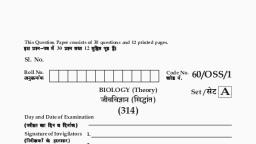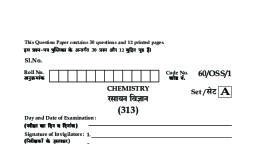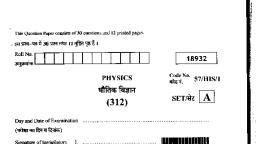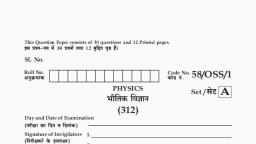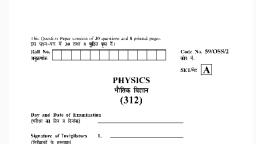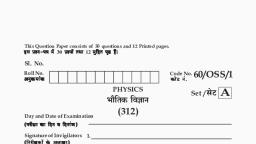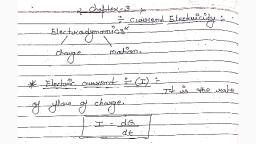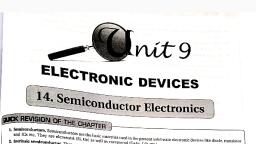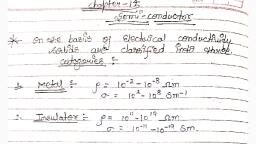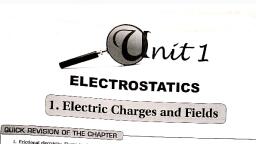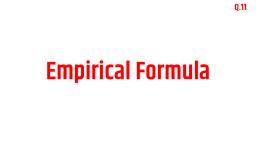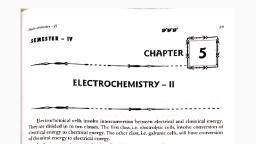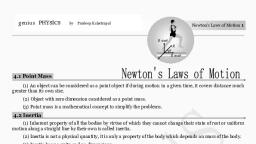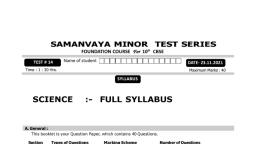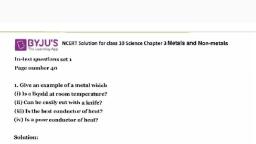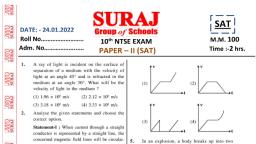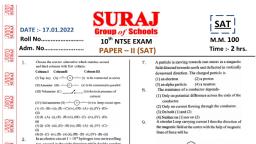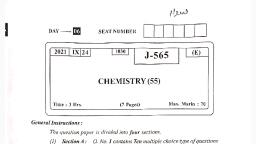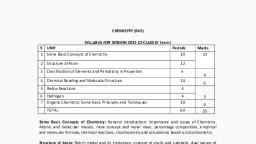Page 1 :
MR. MANISH VERMA, , Mr. Manish Verma as a YOUTUBER &, International Motivational Speakers Professional, Teacher || Problem Consultant || NIOS DU - SOL, Students Coordinator || Founder of Open, schooling Awareness Program || CEO & Founder, of The Life Progress Academy, Social worker., I want to help you all in every way because we, can contribute in any way in the development of, the country which will be a true tribute to the, brave heroes and it will be my first priority to, take the country to a new height for which I have, tried to convert some of my ideas from social, media and from my educational academy into, basalis in which the safety of women, the, education of daughters, is the cause of terror, from the country. Protection of spirit and, environment should be our first priority! Hope, you all get full support in this., ©THE COPYRIGHT ACT 1957., All rights reserved. No part of this publication may be, reproduced, distributed, or transmitted in any form or, by any means, including photocopying, recording, or, other electronic or mechanical methods, without the, prior written permission of the publisher, except in the, case of brief quotations embodied in critical reviews, and certain other noncommercial uses permitted by, copyright, , For more updates visit our web., www.manishvermalpa.com
Page 2 :
Manish Verma, Raise hands with Manish Verma, fear be fearless, , Mr. Manish Verma as a YOUTUBER and Life progress academy Teacher || Problem Advisor ||, Founder of Open Schooling Awareness Program || CEO and founder of Life Progress Academy,, social worker. I want to help you all in every way because we can contribute in any way to the, development of the country which will be a true tribute to, the brave heroes and it will be my first priority to take the, country to a new height for which I, my I am trying to, spread some ideas through social media to all of you! In, which safety of women, education of daughters,, eradication of terror from the country and protection of, environment should be our first priority! Hope all of you, will get full support in this., “Every person in India should be educated, not, , book education but a viable education which is, necessary for both good life and development of, the country….., This has been created so that everyone can understand the, fear of Channel Exam and Study, in an easy way, it is not a, book education but a practical education which is necessary for both good life and, development of the country., If you also want to be famous in this world, then start working hard today because today is the, history of tomorrow ..! By - Manish Verma, All of you are with me, otherwise what is my status!, Manish Verma
Page 3 :
Gratitude, We are all familiar with this fact that unless education is simple, then there are many, difficulties in understanding even the simple things, no matter what the board is. If it is the, matter of NIOS Board, then new students have difficulty in understanding its pattern and, syllabus, and due to lack of correct information, we fail the exam. But after working for many, decades for NIOS students in Manish Verma, I came to know that the large number of, students failing in NIOS is due to lack of proper guidance, guidance and simple book notes., To solve this problem, our team has brought simple notes, important questions and answers, for the exam for NIOS students., The result of our best efforts and tireless hard work is this Chemistry book which includes, notes, which includes the entire syllabus of NIOS. In preparation for which Vicky Verma and, team members of Life Progress Academy contributed and it was ready after months! The, specialist professor of chemistry subjects has helped a lot in this., , Hope you like it a lot and NIOS students will take full advantage of it and bring more marks in, chemistry., , Manish Verma, (NIOS Students Coordinator)
Page 4 :
COURSE OVERVIEW
Page 5 :
CONTENTS
Page 7 :
BLUE PRINT: -
Page 8 :
MODULE-1, (Atoms Molecules & Chemical Arithmetic’s), Chemistry: - Chemistry is the branch of science that deals with the compositions, structure &, properties of matter. Chemistry is called the science of atoms and molecules., , ➢ Branch of Chemistry: •, , Organic Chemistry: - This branch deals with study of carbon compounds especially, hydrocarbons and their derivatives., , •, , Inorganic Chemistry: - This branch deals with the study of compounds of all other, elements except carbon. It largely concerns itself with the study of minerals found in the, Earth’s Crust., , •, , Industrial Chemistry: - The chemistry involved in industrial process is studied under this, branch., , •, , Analytical Chemistry: - This branch deals with the qualitative and quantitative analysis, of various substance., , •, , Biochemistry: - This branch deals with the chemical changes going on in the bodies of, living organisms: plants and animals., , •, , Nuclear Chemistry: - Nuclear reactions, such as nuclear fission, nuclear fusion,, transmutation processes etc. are studied under this branch.
Page 9 :
➢ Properties of measure and their measurement: •, , Properties of matter: - These properties can be classified into two categories – physical, properties and chemical properties., , Physical Properties, 1. Those properties which can be, characteristic, , Chemical Properties, 1. Chemical properties are, , measured or observed without changing, these, , reactions of different substances,, , the identity or the composition of the, , include acidity or basicity,, , substance., , Compustibility etc., , 2. Ex: Colour, odour, melting point, boiling 2. Burning of my-ribbon in air., point, density etc., , • The International System of Units (SI): Base physical Quantity, , Symbol for Quantity, , Name of S.I Unit, , Symbol for S.I Unit, , Length, , L, , Metre, , M, , Mass, , M, , Kilogram, , Kg, , Time, , T, , Second, , S, , Electric current, , I, , Ampere, , A, , Thermodynamic, temperature, , T, , Kelvin, , K, , N, , Mole, , Mol, , Iv, , Condela, , Cd, , Amount of substance, Luminous intensity
Page 10 :
• Prefixes used in the S.I System: Multiple, , Prefix, , Symbol, , 10-12, , Pico, , P, , 10-9, , Nono, , N, , 10-6, , Micro, , U, , 10-3, , Milli, , M, , 10-2, , Centi, , C, , 10-1, , Deci, , D, , 10, , Deca, , Da, , 102, , Hecto, , H, , 103, , Kilo, , K, , 106, , Mega, , M, , 109, , Giga, , G, , 1012, , Tera, , T, , • Differentiate between Mass and Weight: -, , Mass, 1. It is a measure of the number, of atoms or amounts of matter, in an object., 2. It is constant for a body and, does not change with a place., 3. Measured using a beam, balance., 4. Its S.I unit is Kilogram (Kg)., , Weight, 1. It is a force exerted by an object, of fixed mass due to gravity., 2. It is not constant for a body but, it changes from place to place., 3. Measured using a spring, balance., 4. Its S.I unit is Newton (N).
Page 11 :
• Physical Classification of matter: Properties, , Solid, , Liquid, , Gas, , 1., , Volume, , Definite, , Definite, , Indefinite, , 2., , Speed, , Definite, , Indefinite, , Indefinite, , Very High, , Moderate, , Negligible/Very Low, , Orderly arranged., , Free to move within the, volume., , Free to move everywhere., , 3. Intermolecular, Force of attraction, 4. Arrangements of, Molecules, 5. Intermolecular, , Slightly greater, , Very small, , Very Great, , Space, 6. Compressibility, , 7., , Rigidity, , Not Compressibility, , Not Compressibility, , Not Rigid and known as, fluid., , Very Rigid, , Highly Compressible, Not Rigid and known as, fluid., , • Classification of matter: Matter, , Pure substance, , Mixtures, , Homogeneous, mixtures, 1, , Heterogeneous, mixtures, , Elements, , Compounds
Page 12 :
• Write the difference between Mixtures and Compounds: Mixtures, , Compounds, , 1. Constituents may be present, in any ratio., , 1. Constituents are always present, in a fixed ratio by mass., , 2. Always homogeneous in, nature., 3. Constituents cannot be easily, separated by simple, mechanical means., Properties are entirely, different from those of its, constituents., , 2. May or may not be, homogeneous in nature., 3. Constituents can be easily, separated by simple mechanical, means properties are midway, between those of its, constituents., , • Write the difference between Homogeneous & Heterogeneous, Mixture: -, , Homogeneous Mixture, , Heterogeneous Mixture, , 1. It has the same composition, throughout the sample., , 1. It consists of two or more parts,, which have different composition., , 2. Their components cannot be, separate by filteration but, separation take place by distillation, method only., , 2. There components can be, separated by filteration method., , 3. Ex: Salt & Water mixtures, sugar &, water mixtures., , 3. Ex: Mixtures of Sulphur powder &, iron fillings, kerosene oil & water.
Page 13 :
• Laws of Chemical Combination: •, , Law of conservation of mass: - It states that matter can neither be created nor, destroyed it can only convert from one form to another., , •, , Law of definite proportions: - A chemical compounds always consists of the same, elements combined together in the same ratio., , •, , Law of multiple proportions: - When two elements combine to form two or more, compounds, then the different masses of one element which combine with a fixed, mass of the other, bear a simple ratio to one another., , •, , Gay lussac’s law of gaseous volumes: - when gases combine or are produced in a, chemical reaction, they do so in a simple ratio by volume provided all gases are at same, temperature and pressure., , •, , Avogadro law: - According to this law equal volumes of gases at the same, temperature and pressure should contain equal number of molecules., , ➢, , •, •, •, , Dalton’s atomic theory: Matter consists of indivisible atoms., All the atoms of a given element have identical properties including identical mass., Atoms of different elements differ in mass., Compounds are formed when atoms of different elements combine in a fixed ratio., , Empirical Formula and Molecular Formula: An empirical formula represents the simplest whole number ratio of various atoms, present in a compound., e.g. CH is the empirical formula of benzene., , Relationship between empirical and molecular formula: -
Page 14 :
nn = =, , Molecular, formula, Molecular, formula, , Empirical, formula, Empirical, formula, massmass, , Limiting Reagent: - The reactant which gets consumed first or limits the amount of product, formed is known as limiting reagent., , Reactions in Solutions: •, , Mole Fraction: - It is the ratio of number of moles of particular components to the, total number of moles of the solutions., Mole Fraction A =, , No. of moles of A, No. of moles of solutions, , •, , Molarity (M): - It is defined as the number of moles of the solute in 1 litre of the, solution., M =, , No. of moles of solute, Volume of solution in litre, , •, , Molality(m): solvent., , It is defined as the number of moles of solute present in 1 kg of, , m =, , No. of moles of solute, Mass of solvent in kg
Page 15 :
➢Important Questions & Answer: Q1., , Define molar mass of molecular substance?, , Ans. Molecular mass is the sum of atomic masses of the elements present in a molecule., , Q2., , Find the molecular mass of methane., , Ans. (CH4) = (12.011 u) + (1.008 u), = 16.043 u, , Q3., , Write the symbol and meaning of the following prefixes used with SI units?, I., II., , Tera, Pico, Tera = 1012, , Ans. 1., , Pico = 10-12, , 2., , Q4., , 3.0g of H2 react with 30.0g of O2 to form water. Find, 1. The limiting reagent in the reaction, 2. The maximum amount of water that can be formed, 3. The mass of the other reactant which remains unreacted at the end of the reaction., [ Atomic mass: H = 1.0 u, O = 16.0 u], , Ans., 1., , 3.0g of hydrogen will be the limiting reagent., 2H2 + O2, 2H2O, From the above equation it is clear that 2 mole H2 react with 1 mole O2, Molar mass of H2 = 1 × 2= 2g, Molar mass of O2 = 16 × 2 = 32g, , This implies,, 4g H2 react with 32g O2, 3g H2 reacts with = (32/4) × 3g of O2 gas = 8 × 3 = 24g
Page 16 :
As the given amount of O2 is more than required therefore O2 is excess reagent and, H2 is limiting reagent., 2., , 2 mole of hydrogen gas reacts to form 2 mole of water molecules, Therefore,, 4g of H2 produces = 36 g of water, So, the amount of H2O produced by 3 g H2 = (36/4) × 3, = 27 g, Hence, 27 g of water will be produced during the reaction., , 3., , As, 24 g of Oxygen has been utilized during the reaction and 30 g of oxygen was, supplied., Therefore, amount of oxygen gas left is (30 – 24) = 6 g, , Q5. Answer the following questions: 1. Explain as to why there is an increase in temperature observed on mixing water - sulphuric, acid., 2. Calculate molarity of an aqueous solution of KI having density 1.202 g/cm 3 containing 20%, KI by, Mass., [At. Mass: K = 39.0u, I = 127.0u], , Ans., 1. Any acid going into water will heat up the water because of the first effect. Sulphuric, acid shown an exceptionally strong effect because of the extra solvation energy. If you, pour pure sulphuric acid into water, you can actually cause the water to boil., , 2. Molar mass of KI = 127 + 39 = 166 g/mol, Density = 1.202 g/ml, Mass/Mass% = 20%, Mass of solution = 100g, Mass of solute = 20g, Mass of solvent = 80g = 0.08kg, Density = Mass of solution / Volume of solution, 1.202 = 100 / V, V = 100/1.202, V= 83.19ml
Page 18 :
Q7. Calculate the molarity of NaOH in the solution prepared by dissolving its 4 g in enough, water to form 250 mL of the solution., , Solution:, Since molarity (M), = No. of moles of solute, Volume of solution in litres, , = Mass of NaOH/ Molar mass of NaOH, 0.250 L, = 4g / 40g, 0.250 L, = 0.1 mol, 0.250 L, =0.4 mol L-1, =0.4 M, Note that molarity of a solution depends upon temperature because volume of a solution is, temperature dependent.
Page 19 :
Module-2, Atoms Structure and Chemical Arithmetic’s, - Structure of Atom, •, , •, •, •, , Atom is the smallest indivisible particle of the matter. Atom is made of electron,, proton and neutrons., , PARTICLE, , ELECTRON, , PROTON, , NEUTRON, , Discovery, , Sir J.J. Thomson (1869), , Goldstein (1886), , Chadwick (1932), , Nature of charge, , Negative, , Positive, , Neutral, , Amount of charge, , 1.6× 10-19 Coulomb, , 1.6×10-19 Coulomb, , 0, , Mass, , 9.11×10-31kg, , 1.672614×10-27kg, , 1.67492×10-27kg, , Electrons were discovered using cathode ray discharge tube experiment., Nucleus was discovered by Rutherford in 1911., Cathode ray discharge tube experiment: At very low pressure and high voltage,, current starts flowing through a stream of particles moving in the tube from cathode, to anode. These rays were called cathode rays. When a perforated anode was taken,, the cathode rays struck the other end of the glass tube at the fluorescent coating, and a bright spot on the coating was developed., , Results:, a) Cathode rays consist of negatively charged electrons., b) Cathode rays themselves are not visible but their behavior can be observed, with help of fluorescent or phosphorescent materials., c) In absence of electrical or magnetic field cathode rays travel in straight lines., d) In presence of electrical or magnetic field, behavior of cathode rays is similar, to that shown by electrons., e) The characteristics of the cathode rays do not depend upon the material of, the electrodes and the nature of the gas present in the cathode ray tube.
Page 20 :
•, •, •, , Charge to mass ratio of an electron was determined by Thomson. The charge to, mass ratio of an electron as 1.758820 × 1011 C kg-1., Charge on an electron was determined by R A Millikan by using an oil drop, experiment. The value of the charge on an electron is -1.6 × 10-19 C., The mass on an electron was determined by combining the results of Thomson’s, experiment a Millikan’s oil drop experiment. The mass of an electron was, determined to be 9.1094 × 10-31kg., , •, , Discovery of protons canal rays: Modified cathode ray tube experiment was carried, out which led to the discovery of protons., , •, , Characteristics of positively charged particles:, a) Charge to mass ratio of particles depends on gas from which these originate., b) The positively charged particles depend upon the nature of gas present in the, cathode ray discharge tube., c) Some of the positively charged particle carry a multiple of fundamental of, electrical charge., d) Behavior of positively charged particles in electrical or magnetic field is, opposite to that observed for cathode rays., , •, , Neutrons were discovered by James Chadwick by bombarding a thin sheet of, beryllium by α- particles. They are electrically neutral particles having a mass slightly, greater than that of the protons., Atomic number (Z): The number of protons present in the nucleus (Moseley 1913)., Mass number (A): Sum of the number of protons and neutrons present in the, nucleus., Rutherford’s model of atom: This model explained that atom consists of nucleus, which is concentrated in a very small volume. The nucleus comprises of protons and, neutrons. The electrons revolve around the nucleus in fixed orbits. Electrons and, nucleus are held together by electrostatic forces of attraction., , •, •, •, , •, , Drawbacks of Rutherford’s model of atom:, a) According to Rutherford’s model of atom, electrons which are negatively, charged particles revolve around the nucleus in fixed orbits. Thus, the, electrons undergo acceleration., b) According to electromagnetic theory of Maxwell, a charged particle, undergoing acceleration should emit electromagnetic radiation. Thus, an, electron in an orbit should emit radiation. Thus, the orbit should shrink. But, this does not happen., c) The model does not give any information about how electrons are, distributed around nucleus and what are energies of these electrons.
Page 21 :
•, , Isotopes: These are the atoms of the same element having the same atomic number, but different mass number. Ex 1H1, 1H2, 1H3, , •, , Isobars: Isobars are the atoms of different elements having the same mass number, but different atomic number. Ex 18Ag40, 20Ca40, , •, , Isoelectronic species: These are those species which have the same number of, electrons., , •, , Electromagnetic radiations: The radiations which are associated with electrical and, magnetic fields are called electromagnetic radiations. When an electrically charged, particle moves under acceleration, alternating electrical and magnetic fields are, produced and transmitted. These fields are transmitted in the form of waves. These, waves are called electromagnetic waves or electromagnetic radiations., , • Properties of electromagnetic radiations:, a) Oscillating electric and magnetic field are produced by oscillating charged particles., These fields are perpendicular to each other and both are perpendicular to the, direction of propagation of the wave., b) They do not need a medium to travel. That means they can even travel in vacuum., , • Characteristics of electromagnetic radiations:, a) Wavelength: It may be defined as the distance between two neighbouring crests or, troughs of wave as shown. It is denoted by λ., b) Frequency (v): It may be defined as the number of waves which pass through a, particular point in one second., c) Velocity (v): It is defined as the distance travelled by a wave in one second. In, vacuum all types of electromagnetic radiations travel with the same velocity. Its, value is 3X108m sec-1. It is denoted by v., d) Wave number: Wave number is defined as the number of wavelengths per unit, length., ➢ Velocity = frequency × wave length, ➢ C = vλ
Page 22 :
•, , Planck’s Quantum Theory▪ The radiant energy is emitted or absorbed not continuously but, discontinuously in the form of small discrete packets of energy called, ‘quantum’. In case of light, the quantum of energy is called a ‘photon’., ▪ The energy of each quantum is directly proportional to the frequency of the, radiation, i.e., E α v or E= hv; where h= Planck’s constant = 6.626 × 10 -27 Js, ▪ Energy is always emitted or absorbed as integral multiple of this quantum., E=nhv; where n=1,2,3,4…..., , •, , Black body: An ideal body, which emits and absorbs all frequencies, is called a black, body. The radiation emitted by such a body is called black body radiation., , •, , Photoelectric effect: The phenomenon of ejection of electrons from the surface of, metal when light of suitable frequency strikes it is called photoelectric effect. The, ejected electrons are called photoelectrons., , •, , Experimental results observed for the experiment of photoelectric effecto When beam of light falls on a metal surface electron are ejected immediately., o Number of electrons ejected is proportional to intensity or brightness of light., , o Threshold frequency (vo): For each metal there is a characteristic minimum, frequency below which photoelectric effect is not observed. This is called, threshold frequency., o If frequency of light is less than the threshold frequency there is no ejection, of electrons no matter how long it falls on surface or how high is its intensity., •, •, •, , •, , Photoelectric work function (Wo): The minimum energy required to eject electrons, is called photoelectric work function. Wo= hvo, Energy of the ejected electrons:, h(v-v0) = 1/2mev2, Dual behavior of electromagnetic radiation- The light possesses both particle and, wave like properties, i.e., light has dual behavior. Whenever radiation interacts with, matter, it displays particle like properties (Black body radiation and photoelectric, effect). Wave like properties are exhibited when it propagates (interference a, diffraction)., When a white light passed through a prism, it splits into a series of colored bands, known as spectrum.
Page 23 :
•, , •, , Spectrum is of two types: continuous and line spectrum, a) The spectrum which consists of all the wavelengths is called continuous., b) A spectrum in which only specific wavelengths are present is known as a line, spectrum. It has bright lines with dark spaces between them., Electromagnetic spectrum is a continuous spectrum. It consists of a range of, electromagnetic radiations arranged in the order of increasing wavelengths or, decreasing frequencies. It extends from radio waves to gamma rays., Spectrum is also classified as emission and line spectrum., o Emission spectrum: The spectrum of radiation emitted by a substance that, has absorbed energy is called an emission spectrum., o Absorption spectrum is the spectrum obtained when radiation is passed, through a sample of material. The sample absorbs radiation of certain, wavelengths. The wavelengths which are absorbed missing and come as dark, lines., The study of emission or absorption spectra is referred as spectroscopy., , •, , Spectral Lines for atomic hydrogen:, , •, , •, , Series, , N1, , N2, , Lyman, , 1, , 2,3,4, 5..., , Spectral, Region, , Balmer, , 2, , 3,4,5…, , Ultraviolet, , Paschen, , 3, , 4,5…, , Visible, , Brackett, , 4, , 5,6…, , Infrared, , Pfund, , 5, , 6,7…, , Infrared, Infrared, , • Rydberg equation, v̅ = 109.677 (1/n12 – 1/n22) cm-1, R= Rydberg’s constant = 109677 cm-1, , • Bohr’s model for hydrogen atom:, a) An electron in the hydrogen atom can move around the nucleus in a circular path, of fixed radius and energy. These paths are called orbits or energy levels. These, orbits are arranged concentrically around the nucleus., b) As long as an electron remains in a particular orbit, it does not lose or gain, energy and its energy remains constant.
Page 24 :
c) When transition occurs between two stationary states that differ in energy, the, frequency of the radiation absorbed or emitted can be calculated, V= ∆𝐸 = E2 - E1, h, h, d) An electron can move only in those orbits for which its angular momentum is an, integral multiple of h/2𝜋, e) me vr = n. h/2𝜋 n= 1,2,3, …, •, •, , The radius of the nth orbit is given by rn =52.9 pm × n2/Z, Energy of electron in nth orbit is:, En = -2.18 × 10-18 (Z2/n2) J, , •, , Limitations of Bohr’s model of atom:, a) Bohr’s model failed to account for the finer details of the hydrogen spectrum., b) Bohr’s model was also unable to explain spectrum of atoms containing more, than one electron., , •, , Dual behavior of matter: Broglie proposed that matter exhibits dual behavior i.e.,, matter shows both particle and wave nature. Broglie’s relation is, λ = h/mv = h/p, , •, , •, , Heisenberg’s uncertainty principle: It states that it is impossible to determine, simultaneously, the exact position and exact momentum of an electron. The product, of their uncertainties is always equal to or greater than h/4𝜋., Mathematically ∆𝑥 × ∆𝑝 ≥ ℎ/4𝜋, Where, ∆𝑥 = 𝑢𝑛𝑐𝑒𝑟𝑡𝑎𝑖𝑛𝑖𝑡𝑦 𝑖𝑛 𝑝𝑜𝑠𝑖𝑡𝑖𝑜𝑛, ∆𝑝 = 𝑢𝑛𝑐𝑒𝑟𝑡𝑎𝑖𝑛𝑖𝑡𝑦 𝑖𝑛 𝑚𝑜𝑚𝑒𝑛𝑡𝑢𝑚, Heisenberg’s uncertainty principle rules out the existence of definite paths or, trajectories of electrons and other similar particles., , •, , Failure of Bohr’s model:, a) It ignores the dual behavior of matter., b) It contradicts Heisenberg’s uncertainty principle., , •, , Classical mechanics is based on Newton’s laws of motion. It successfully describes, the motion of macroscopic particles but fails in the case of microscopic particles.
Page 25 :
• Quantum mechanical model an atom: o Principle quantum number (n): n defines the shell, determines the size of the, orbital and also to a large extent the energy of the orbital., N, , 1, , 2, , 3, , 4, , Shell No., , K, , L, , M, , N, , Total number of orbitals, in a shell = n2, , 1, , 4, , 9, , 16, , 2, , 8, , 18, , 32, , Maximum number of, electrons = 2n2, , o Azimuthal quantum number (I): There are n subshells in the nth shell. L, identifies the subshell and determines the shape of the orbital., There are (2l + 1) orbitals of each type in a subshell, that is, one s orbital (l =, 0), three p orbitals (l = 1) and five d orbitals (l = 2) per subshell., o Magnetic quantum number or Magnetic orbital quantum number (ml): ml, designates the orientation of the orbital. For a given value of l, m l, has (2l + 1), values, the same as the number of orbitals per subshell., o Electron spin quantum number (ms): ms refers to orientation of the spin of, the electron., , Ques: - What is the total number of orbitals associated where the principle quantum, number n = 3?, Solution: 1. For n = 3, the possible values of l are 0,1 and 2. Thus there is one 3s orbital (n =3, l =0, and ml =0)., 2. There are three 3p orbitals (n =3, l =1 and ml =-1, 0, +1), 3. There are five 3d orbitals (n =3, l =2 and ml =-2, -1, 0, +1, +2)., Therefore, the total number of orbitals is 1+3+5 =9.
Page 26 :
Ques: - Using s, p, d, f notations, describe the orbital with the following quantum, numbers: a), b), c), d), , N =2, l =1,, N =4, l =0,, N =5, l =3,, N =3, l =2, , •, , L, , N, , Solution: -, , Orbital, , a), , 2, , 1, , 2p, , b), , 4, , 0, , 4s, , c), , 5, , 3, , 5f, , d), , 3, , 2, , 3d, , Shielding effect or screening effect: Due to the presence of electrons in the inner, shells, the electron in the outer shell will not experience the full positive charge on, the nucleus., So, due to the screening effect, the net positive charge experienced by the electron, from the nucleus is lowered and is known as effective nuclear charge. Effective, nuclear charge experienced by the orbital decreases with increase of azimuthal, quantum number (1)., , •, , Aufbau Principle: In the ground state of the atoms, the orbitals are filled in order of, their increasing energies., , •, , N+1 rule-orbitals with lower value of (n+1) have lower energy. If two orbitals have, the same value of (n+1) then orbital with lower value of n will have lower energy., , •, , The order in which the orbitals are filled is as follows:, 1s, 2s, 2p, 3s, 3p, 4s, 3d, 4p, 5s, 4d, 5p, 4f, 5d, 6p, 7s …., , •, , Pauli Exclusion Principle: NO two electrons in an atom can have the same set of four, quantum numbers. Only two electrons may exist in the same orbital and these, electrons must have opposite spin.
Page 27 :
•, , Hund’s rule of maximum multiplicity: Pairing of electrons in the orbitals belonging, to the same subshell (p, d or f) does not take place until each orbital to that subshell, has got one electron each i.e., it is singly occupied., , •, , Electronic configuration of atoms: Arrangement of electrons in different orbitals of, an atom. The electronic configuration of different atoms can be represented in two, ways., a) Sapbdc…notation, b) Orbital diagram: Each orbital of the subshell is represented by a box and the, electron is represented by an arrow (↑) a positive spin or an arrow (↓) a, negative spin, , •, , Stability of completely filled and half-filled subshells:, a) Symmetrical distribution of electrons- the completely filled or half- filled, sub-shells have symmetrical distribution of electrons in them and are more, stable., , b) Exchange energy- The two or more electrons with the same spin present in, the degenerate orbitals of a sub-shell can exchange is called exchange, energy. The number of exchanges is maximum when the subshell is either, half-filled or completely filled. As a result, the exchange energy is maximum, and so is the stability.
Page 28 :
• Shapes of Atomic Orbitals: -, , Ques:1 How many neutrons and protons are there in the following nuclei?, 6, , 13C, 16O, 24Mg, 56Fe, 88Sr, 8, 12, 26, 38, , Ans:, 6, , 13C:, , Atomic mass= 13, Atomic number = Number of protons = 6, Number of neutrons = (Atomic mass) – (Atomic number), 13 – 6 = 7
Page 29 :
8, , 16O:, , Atomic mass = 16, Atomic number = 8, Number of protons = 8, Number of neutrons = (Atomic mass) - (Atomic number), 16 – 8 = 8, , 12, , 24Mg:, , Atomic mass = 24, Atomic number = Number of protons = 12, Number of neutrons = (Atomic mass) - (Atomic number), 24 – 12 = 12, , 26, , 56Fe:, , Atomic mass = 56, Atomic number = Number of protons = 26, Number of neutrons = (Atomic mass) - (Atomic number), 56 – 26 = 30, , 38, , 88Sr:, , Atomic mass = 88, Atomic number = Number of protons = 38, Number of neutrons = (Atomic mass) - (Atomic number), 88 – 38 = 50
Page 30 :
Ques:2 Yellow light emitted from a sodium lamp has a wavelength (λ) of 580nm. Calculate, the frequency (v) and wave number (v̅) of the yellow light., Ans: From the expression,, λ = c/v, We get,, V= c/λ…… (1), Where,, V = frequency of yellow light, C = velocity of light in vacuum = 3 × 108 m/s, λ = wavelength of yellow light = 580nm = 580 × 10-9 m, Substituting the values in expression (1):, V= 3 × 108, , ͇ 5.17 × 1014s-1, , 580 × 10-9, Thus, the frequency of yellow light emitted from the sodium lamp, = 5.17 × 1014s-1, Wave number of yellow lights, v̅ = 1/λ, = 1/580 × 10-9 = 1.72 × 106m-1, , Ques:3 Calculate the wavelength, frequency and wave number of a light wave whose, period is 2.0 × 10-10s., , Ans: Frequency (v) of light = 1/Period, = 1/ 2.0 × 10-10s = 5.0 × 109s-1, Wavelength (λ) of light = c/v, Where,, C= velocity of light in vacuum = 3 × 108 m/s, Substituting the value in the given expression of λ:, λ= 3 × 108 / 5.0 × 109 = 6.0 × 10-2m, Wave number (v̅) of light = 1/λ = 1 / 6.0 × 10-2 = 1.66 × 101m-1
Page 31 :
Ques:4 What is the number of photons of light with a wavelength of 4000 pm that provide, 1 J of energy?, , Ans: Energy (E) of a photon = hv, Energy (En) of ‘n’ photons = nhv, = n= Enλ / hc, Where,, λ= wavelength of light = 4000 pm = 4000 × 10-12m, c= velocity of light in vacuum = 3 × 108 m/s, h= Planck’s constant = 6.626 × 10-34 Js, Substituting the values in the given expression of n:, N= (1) × (4000 × 10-12) / (6.626 × 10-34) (3 × 108), = 2.012 × 1016, Hence, the number of photons with a wavelength of 4000 pm and energy of 1 J are 2.012 ×, 1016., , Ques:5 What is the maximum number of emission lines when the excited electron of an H, atom in n = 6 drops to the ground state?, , Ans: When the excited electron of an H atom in n = 6 drops to the ground state, the, following transitions are possible:, Hence, a total number of (5+ 4+ 3+ 2+ 1) 15 lines will be obtained in the emission spectrum., The number of spectral lines produced when an electron in the nth level drops down the, ground state is given by n (n – 1) / 2, Given, n= 6, Number of spectral lines = 6 (6 – 1) / 2 = 15.
Page 32 :
Ques:6 Calculate the wavelength of an electron moving with a velocity of 2.05 × 107 ms-1., Ans: According to de Broglie’s equation,, λ= h/mv, Where,, λ= wavelength of moving particle, m= mass of particle, v= velocity of particle, h= Planck’s constant, Substituting the values in the expression of λ:, λ= 6.626 × 10-34 / (9.10939 × 10-31kg) (2.05 × 107 ms-1), λ= 3.548 × 10-11m.
Page 33 :
Ques:7 Explain, giving reasons, which of the following sets of quantum numbers are not, possible., a), b), c), d), e), f), , N = 0; l = 0; ml = 0; ms= +1/2, N = 1; l = 0; ml = 0; ms= +1/2, N = 1; l = 1; ml = 0; ms= +1/2, N = 2; l = 1; ml = 0; ms= +1/2, N = 3; l = 3; ml = -3; ms= +1/2, N = 3; l = 1; ml = 0; ms= +1/2, , Ans:, a) The given set of quantum numbers is not possible because the value of the principle, quantum number (n) cannot be zero., b) The given set of quantum number is possible., c) The given set of quantum numbers is not possible., For a given value of n, ‘I’ can have values from zero to (n – 1)., For n = 1, l = 0 and not 1., d) The given set of quantum numbers is possible., e) The given set of quantum numbers is not possible., For n= 3,, l = 0 to (3 – 1), l = 0 to 2 i.e., 0,1,2, f) The given set of quantum numbers is possible.
Page 37 :
CLASSIFICATION OF ELEMENTS AND PERIODICITY IN PROPERTIES OF, ELEMENTS, ➢ Mendeleev’s Periodic Law: - The properties of the elements are the periodic, function of their atomic masses., Moseley, the English physicist showed that atomic number is more fundamental property of, an element than its atomic mass. Therefore, the position of an element in the periodic table, depends on its atomic number than its atomic mass., , •, , Modern Periodic Law: - The physical and chemical properties of elements are, the periodic functions of their atomic numbers., , Types of Elements: s-, p-, d-, and f- blocks., , ➢ MAIN GROUP ELEMENTS/ REPRESENTATIVE ELEMENTS:, The s- and p- block elements are called main group elements or representative elements., , •, , s- block elements: Group-1 (Alkali metals) and Group-2 elements (Alkaline earth, metals) which respectively have ns1 and ns2 outermost electronic configurations.
Page 38 :
•, , p- block elements: They belongs to group- 13 to 18. The outermost electronic, configuration is ns2 np1-6. He (1s2) is a s- block element but is positioned with the, group 18 elements (ns2 np6) because it has completely filled valence shell and as a, result, exhibits properties characteristics of other noble gases., , •, , d- block elements (Transition elements): are the elements of group 3 to 12 having, outer electronic configuration (n-1) d1-10 ns1-2. Four transition series are 3d, 4d, 5d, and 6d. The 6d- series is incomplete. Atomic radius generally decreases across a, period and increases as we descend the group.
Page 39 :
•, , f- block elements (Inner- transition series): Lanthanoids characterized by the filling, of 4 f- orbitals, are the elements following lanthanum from 58Ce to 71Lu. Actinoids, characterized by filling of 5f- orbitals, are the elements following actinium from 70th, to 103Lr. Characteristics outer electronic configuration is (n-2) f1-14 (n-1) d0-1 ns2., , Noble Gases: The gaseous elements of group 18 are called noble gases. The general, outermost electronic configuration of noble gases (except He) is ns2 np6. He exceptionally, has 1s2 configuration. Thus, the outermost shell of noble gases is completely filled., , Periodicity: The repetition of similar properties after regular intervals is called periodicity., Cause of periodicity: The properties of elements are the periodic repetition of similar, electronic configuration of elements as the atomic number increases., , Atomic Properties: The physical characteristics of the atom of an element are called, atomic properties The properties such as atomic radius, ionic radius, ionisation energy,, electro- negativity, electron affinity and valence etc., called atomic properties., , •, , Atomic radius: The distance from the centre of the nucleus to the outermost shell, of the electrons in the atom of any element is called its atomic radius., , •, , Periodicity- (a) In period- Atomic radius of elements decreases from left to right in, a period., (b) in Group- Atomic radius of elements increases on moving top to bottom in a, group.
Page 40 :
•, , COVALENT RADIUS- Half the inter-nuclear distance between two similar atoms of, any element which are covalently bonded to each other by a single covalent bond is, called covalent radius., , •, , VAN DER WAAL’S RADIUS: Half the inter-nuclear separation between two, similar adjacent atoms belonging to the two neighbouring molecules of the same, substance in the solid state is called the van der waal’s radius of that atom., , •, , METALLIC RADIUS: Half the distance between the nuclei of the two adjacent, , •, , metal atoms in a close packed lattice of the metal is called its metallic radius., Van der Waal’s radius ˃ Metallic radius ˃ Covalent radius, , •, , IONIC RADIUS: The effective distance from the centre of the nucleus of an ion up, to which it has an influence on its electron cloud is called its ionic radius.
Page 41 :
A cation is smaller but the anion is larger than the parent atom. In case of isoelectronic species, the cation with greater positive charge has smaller radius but, anion with greater negative charge has the larger radii., •, , IONISATION ENTHALPY: The ionisation enthalpy is the molar enthalpy change, accompanying the removal of an electron from a gaseous phase atom or ion in its, ground state. Thus, enthalpy change for the reaction; M(g) = M+ (g) + eIs the ionisation enthalpy of the element M. Like ionisation energies for successive, ionisation, the successive ionisation enthalpy may also be termed as 2 nd ionisation, enthalpy (∆rH2), third ionisation enthalpy (∆rH3) etc. The term ionisation enthalpy is, taken for the first ionisation enthalpy, (∆rH1) is expressed in kg mol- or in eV., , • PERIODICITY:, i., ii., iii., , Generally, the ionisation enthalpies follow the order (there are few exceptions):, (∆rH1) ˂ (∆rH2) ˂ (∆rH3), The ionisation enthalpy decreases on moving top to bottom in a group., The ionisation enthalpy increases on moving from left to right in a period., , • ELECTRON GAIN ENTHALPY: It is defined as electron is added to a neutral, gaseous atom (X) to convert it into a negative ion, the enthalpy change, accompanying the process is defined as the Electron Gain Enthalpy (∆egH)., , • Periodicity: i., In period- The electron gain enthalpy increases from left to right in a, period., ii., , In period- The electron gain enthalpy decreases from top to bottom in a, group., , ELECTRONEGATIVITY: - “The relative tendency of an atom in a molecule to attract the, shared pair of electrons towards itself is termed as its electro-negativity.”, Periodicity:, i., ii., , In period- The electro-negativity increases from left to right in a period., In group- The electro-negativity decreases from top to bottom in a group.
Page 42 :
VALENCE ELECTRONS: - The electrons present in outermost shell are called as valence, electron. Because the electrons in the outermost shell determine the valency of an element., , Periodicity:, i., ii., , In period- The valency first increases then decreases from left to right in a period., In group- The valency remains constant from top to bottom in a group., , ELECTROPOSITIVE OR METALLIC CHARACTER: The tendency of an element to lose, electrons and forms positive ions (cations) is called electropositive or metallic character. The, elements having lower ionisation energies have higher tendency to lose electrons, thus they, are electropositive or metallic in their behavior., Alkali metals are the most highly electropositive elements., , Periodicity:, In period: The electropositive or metallic characters decreases from left to right in a, period., , In group: The electropositive or metallic characters increases from top to bottom in a, group., , ELECTRO- NEGATIVE OR NON- METALLIC CHARACTERS: The tendency of, an element to accept electrons to form an anion is called its non- metallic or electronegative, character. The elements having high electro- negativity have higher tendency to gain, electrons and forms anion. So, the elements in the upper right-hand portion of the periodic, table are electro- negative or non- metallic in nature., , Periodicity:, In period- The tendency of an element to lose electrons decreases in a period. So, the, reactivity of metals decreases from left to right in a period., , In group- The tendency of an element to lose electrons increases in a period. So, the, reactivity of metals increases from top to bottom in a group.
Page 43 :
REACTIVITY OF METALS:, Periodicity:, •, , In period- The tendency of an element to lose electrons decrease in a period. So,, , •, , the reactivity of metals decreases from left to right in a period., In group- The tendency of an element to lose electrons to lose electrons increases, in a period. So, the reactivity of metals increases from top to bottom in a group., , REACTIVITY OF NON- METALS:, •, , In period- The tendency of an element to gain electrons increases in a period. So,, , •, , the reactivity of non- metals increases from left to right in a period., In group- The tendency of an element to gain electrons decreases in a group. So,, the reactivity of non- metals increases from top to bottom in a group., , SOLUBILITY OF ALKALI METALS CARBONATES AND BICARBONATES:, PERIODICITY IN GROUP: The solubility of alkali metal carbonates and bicarbonates in, water increases down the group (from Lithium to Caesium)., , SOLUBILITY OF ALKALINE EARTH METAL HYDROXIDES AND, SULPHATES:, PERIODICITY IN GROUP: The solubility of alkaline earth metal hydroxide in water, increases down the group (from Beryllium to Barium)., , BASIC STRENGTH OF ALKALINE EARTH METAL HYDROXIDES:, PERIODICITY IN GROUP: The basic strength of alkaline earth metal hydroxide in water, increases down the group (from Beryllium to Barium), i.e.,, Be (OH)2 < Mg (OH)2 < Ca (OH)2 < Sr (OH)2 < Ba (OH)2, Basic strength increases
Page 44 :
THERMAL STABILITY OF CARBONATES OF ALKALI AND ALKALINE, EARTH METALS:, Except lithium carbonate, (LiCO3), the carbonates of all other alkali metals are stable, towards heat, i.e., carbonates of alkali metals (except LiCO3) do not decompose on heating, LiCO3 decomposes on heating to give lithium oxide (LiCO3)., The carbonates of alkaline earth metals are relatively less stable. On heating, they, decompose to give corresponding oxide and Co2 gas. The decomposition temperature for, alkaline earth metal carbonates increases as we go down the group., , Anomalous Properties of Second Period Elements, Their anomalous behavior is attributed to their small size, large charge/radius ratio, high, electro negativity, non-availability of d-orbitals in their valence shell. The first member of, each group of p-block elements displays grater ability to form pp-pp multiple bonds to itself, (e.g., C=C, C≡C O=O, N≡N) and to other second period elements (e.g., C=O, C≡N, N=O), compared to subsequent member of the group., , Ques:1 Energy of an electron in the ground state of the hydrogen atom is 2.18 × 10-18 J. Calculate the ionization enthalpy of atomic hydrogen in terms, of J mol-1., Ans: It is given that the energy of an electron in the ground state of the hydrogen atom is, -2.18 × 10-18., Therefore, the energy required to remove that electron from the ground state of hydrogen, atom is, 2.18 × 10-18 J., Therefore,, Ionization enthalpy of atomic hydrogen= -2.18 × 10-18, Hence, ionization enthalpy of atomic hydrogen in terms of J mol-1 = 2.18 × 10-18 × 6.02 × 1023, J mol-1 = 1.31 × 106 J mol-1.
Page 45 :
Ques:2 Would you expect the second electron gain enthalpy of O as positive,, more negative or less negative than the first? Justify your answer., Ans: When an electron is added to O atom to form O- “ion, energy is released. Thus, the, first electron gain enthalpy of O is negative., O(g) + e- = O-(g), On the other hand, when an electron is added to O- ion to form O2- ion, energy has to be, given out in order to overcome the strong electronic repulsions. Thus, the second electron, gain enthalpy of O is positive., O-(g) + e- = O2-(g)
Page 46 :
CHEMICAL BONDING AND MOLECULAR STRUCTURE: Chemical bonding: The attractive force which holds various constituents (atoms, ions,, etc.) together in different chemical species is called a chemical bond., , Ionic bond: The bond formed as a result of electrostatic attraction between the positive, and negative ions was termed as electrovalent bond., , LEWIS SYMBOL:, , OCTED RULE:, According to this, atoms can combine either by transfer of valence electrons from one atom, to another (gaining or losing) or by sharing of valence electrons in order to have an octet in, their valence shells. This is known as octet rule., , COVALENT BOND: The bond formed by sharing of electrons is known as covalent bond.
Page 47 :
Types of Covalent Bond:, 1. Single Covalent: When two atoms, share one electron pair they are said to, be joined by a single covalent bond., , 2. Double Covalent: If two atoms share two pairs of electrons, the covalent bond, between them is called double bond., , 3. Triple Covalent: When combining atoms share three electron pairs as in the case, of two nitrogen atoms in the N2 molecule and the two carbon atoms in the ethyne, molecule, a triple bond is formed.
Page 50 :
vi., , CO, , FORMULA CHARGE:, Valence electron – lone pair electron – ½ bond pair electron, , Example:, OZONE (O3):, , The atoms have been numbered as 1, 2 and 3. The formal charge on:, •, , The central O atom marked 1, = 6 - 2 – ½ (6) =+1, , •, , The end O atom marked 2, = 6 – 4 – ½ (4) = 0, , •, , The end O atom marked 3, = 6 – 6 – ½ (2) = -1
Page 52 :
SF6, , 3., , Odd- electron molecules, NO, , POLARITY OF BOND: COVALENT BOND, , POLAR, e.g., H- Cl, (electronegativity, Difference), , NON-POLAR, e.g., Cl – Cl, (same electro-negativity)
Page 53 :
DIPOLE MOMENT: It is defined as the product of the magnitude of the charge and the, distance between the centre’s of the positive and negative charge., Dipole moment (𝝁) = charge (Q) × distance of separation (r), Dipole moment is usually expressed in Debye units (D). The conversion factor is, 1 D = 3.33564 × 10-30 Cm, where C is coulomb and m is meter., , VSEPR THEORY: Valence shell electron pair repulsion theory., The repulsive interaction of electron pairs decreases in the order:, Lone pair (lp) – Lone pair (lp) ˃ Lone pair (lp) – Bond pair (bp) ˃ Bond pair (bp) – Bond pair, (bp)., i., ii., iii., , Molecules in which the central atom has no lone pair, and, Molecules in which the central atom has one or more lone pairs., Shape linear planer, tetrahedral, trigonal- bipyramidal and octahedral.
Page 54 :
Geometry of Molecules in which the Central Atom has, No Lone Pair of Electrons
Page 55 :
Shape of Some Simple Molecules/Ions with Central Ions, having One or More Lone Pairs of Electrons:
Page 56 :
VALENCE BOND THEORY: Types of Overlapping and Nature of Covalent Bonds:, The covalent bond may be classified into two types depending upon the types of, overlapping:, i., , Sigma (𝝈) bond: This type of bond is formed by the end to end (head-on) overlap, of bonding orbitals along the internuclear axis. This is called as head on overlap or, axial overlap., , •, , s-s overlapping: There is overlap of two half -filled s-orbitals along the, internuclear axis as shown below:, , •, , s-p overlapping: This type of overlap occurs between half -filled s-orbitals of one, atom and half-filled p-orbitals of another atom., , •, , p-p overlapping: This type of overlap takes place between half filled p-orbitals of, the two approaching atoms.
Page 57 :
ii., , pi (𝝅) bond: - In the formation of 𝜋 bond the atomic orbitals overlap in such a, way that their axes remain parallel to each other and perpendicular to the, internuclear axis. The orbitals formed due to sidewise overlapping consists of two, saucer type charged clouds above and below the plane of the participating atoms., , • Strength of Sigma and pi Bonds:, The strength of a bond depends upon the extent of overlapping. In case of sigma bond, the, overlapping of orbitals takes place to a larger extent. Hence, it is stronger as compared to, the pi bond where the extent of overlapping occurs to a smaller extent., , DIFFERENCE BETWEEN SIGMA AND PI BOND:, Sigma Bond, , pi Bond, , 1) It is formed by sharing head, overlapping., , 1) It is formed by sharing of side, overlapping., , 2) Sigma bond are strong., , 2) pi bond is weak., , 3) p-p, s-s, and p-s, , 3) p-p, , 4) Free rotation about sigma bond, is possible., , 4) Rotation is restricted., , HYBRIDISATION:, Salient features of hybridisation:, 1. The number of hybrid orbitals is equal to the number of the atomic orbitals that get, hybridized., 2. The hybridized orbitals are always equivalent in energy and shape., 3. The hybrid orbitals are more effective in forming stable bonds than the pure atomic, orbitals., 4. These hybrid orbitals are directed in space in some preferred direction to have, minimum repulsion between electron pairs and thus a table arrangement., Therefore, the type of hybridization indicates the geometry of the molecules.
Page 59 :
ii., , sp2 hybridisation: In this hybridisation there is involvement of one s and two porbitals in order to form three equivalent sp2 hybridised orbitals., , iii., , sp3 hybridisation: This type of hybridisation can be explained by taking the, example of CH4 molecule in which there is mixing of one s-orbital and three porbitals of the valence shell to form sp3 hybrid orbital of equivalent energies and, shape. There is 25% s-character and 75% p-character in each sp3 hybrid orbital.
Page 64 :
• Condition for combination at atomic orbitals:, 1) The combining atomic orbital must have the same or nearly energy., 2) The combining atomic orbital must have the same symmetry about molecular axis., 3) The combining atomic orbital must over lose to the maximum extents., , • HYDROGEN BONDING:, Hydrogen bond can be defined as the attractive fares which binds hydrogen one molecule, with the electronegative atom (F, O or N) of another molecules., , • Types of Hydrogen Bond1) Intermolecular H- Bond: It is formed between two different molecules at the, same or different compounds., , 2) Intramolecular H- Bond: It is formed when Hydrogen atom in is between highly, electronegativity (F, O, N) present in some molecules.
Page 65 :
MODULE: - 3, STATES OF MATTERS, ➢ Gaseous State, • LONDON FORCE, 1. This force acts in non-polar molecules and atoms., 2. It is a force at attraction between the two-temporary dipole., 3. This force is always attractive.
Page 66 :
• DIPOLE- DIPOLE FORCE: 1. This force acts between polar molecules., 2. The polar molecule interacts the neighbouring molecule. This is called Dipole-dipole, force., 3. This force stronger than London force but weaker than ione-ione force., 4. The attractive force decreases with the increase of distance between the dipoles., , • DIPOLE – INDUCED DIPOLE FORCES: 1. This type at attractive forces act between polar and a non-polar molecule., 2. Permanent dipole of polar molecule induced dipole is non-polar molecule and then, both the molecules attract each other, this force of attraction is called dipole, induced dipole., 3. It is the force of attraction between electronegative element (f, o, n) of one, molecule with hydrogen atom at another molecule., London force < dipole induced dipole < dipole-dipole < H- Bond < ionic Bond
Page 67 :
• THERMAL ENERGY: It is the energy of a body arising from motion of its atoms or molecules., , Properties of Gaseous state: •, •, •, •, •, , Gases are highly compressible., Gases exert pressure equally in all directions., Gases have much lower density than the solids and liquids., The volume and the shape of gases are not fixed. These assume volume and shape of, the container., Gases mix evenly and completely in all proportions without any mechanical aid., , ➢ GASEOUS LAW: 1. Boyle’s law: At constant temperature, the pressure of a fixed amount of gas varies, inversely with its volume. This is known as Boyle’s law., p α 1/v (at constant T and n), p = k1 1/v, pv = k, p1V1 = p2V2 = constant, p1/p2 = V2/V1
Page 69 :
➢ Gay Lussac’s Law (Pressure – Temperature Relationship), At constant volume, pressure of a fixed amount of a gas varies directly with the, temperature., PαT, p/T = constant = k3
Page 70 :
➢ Avogadro Law (Volume – Amount Relationship), It states that equal volumes of all gases under the same conditions of temperature and, pressure contain equal number of molecules., V α n (where n is the number of moles of the gas), V = kn, , Ideal gas: A gas that follows Boyle’s law, Charles’ law and Avogadro law strictly is called, an ideal gas., , Ideal gas Equation:, V α 1/p (Boyle’s Law), V α T (Charles Law), V α n (Avogadro Law), V α nT/p, V = RnT/p, Pv = nRT (ideal gas constant), , DALTON’S LAW OF PARTIAL PRESSURE:, It states that the total pressure exerted by the mixture of non- reactive gases is equal to the, sum of the partial pressures of individual gases., PT = P1 + P2 + P3+……... (at constant T, V)
Page 72 :
M = dRT/P, , Values of R, PV = nRT, R = PV / nT, At STP (standard Temi and Pressure), , ➢ Kinetic molecular theory of gases: 1. The intermolecular force of attraction operating between molecules is negligible &, the effect of gravity on molecule is also negligible., 2. The gases molecule to tiny to considered their size. Hence their collision is perfect, elastic., , 3. The collision of gaseous molecules is perfect elastic. Hence, the initial momentum of, molecules will be equal to final momentum., 4. There will be no energy lose during the collision of molecules from wall of vessel., , 5. The pressure and volume of gas is applied or exerted by container walls. On, molecules and volume of gas is the volume of container., 6. The motion of gaseous molecules followed straight path. Newton Laws of motion is, valid for ideal gas molecules.
Page 73 :
LIQUID STATE: Intermolecular forces are stronger in liquid state than in gaseous state., 1. Properties of liquids: Molecules in liquids are so close that there is very little empty, space between them and under normal conditions liquids are denser than gases., 2. Molecules of liquids are held together by attractive intermolecular forces. Liquids, have definite volume because molecules do not separate from each other., 3. Molecules of liquids can move past one another freely, therefore, liquids can flow,, can be poured and can assume the shape of the container in which these are stored., Vapour Pressure of a liquid at any temperature may be defined as the pressure exerted by, the vapour present above the liquid in equilibrium with the liquid at that temperature., , • Factors affecting vapour pressure: 1. Nature of the liquid: If the intermolecular forces of attraction in the liquid are, weak, the molecules can easily leave the liquid and come into the vapour phase and, hence the vapour pressure is higher., 2. Effect of temperature: As the temperature of a liquid is increased, the vapour, pressure of the liquid increases., , Boiling point of a liquid is defined as the temperature at which the vapour pressure of the, liquid becomes equal to the external pressure., When the external pressure is normal atmospheric pressure, the boiling point is called the, normal boiling point., When the external pressure is equal to 1 bar, the boiling point is called standard boiling, point of the liquid., , Some Application of Effect of External Pressure on Boiling point:, 1. Obviously, if the external pressure is higher, more heat will be required to make the, vapour pressure equal to the external pressure and hence higher will be the boiling, point. That is why in hospitals, surgical instruments are sterilized in autoclaves in, which boiling point of water is raised by using a weight to cover the vent., 2. Similarly, if the external pressure is decreased, the boiling point is lowered. This is, the reason that a liquid boil at a lower temperature on the top of a mountain (where, pressure is low) than on the sea shore. That is why at hills, use of pressure cooker is, essential for cooking food.
Page 74 :
➢ SURFACE TENSION:, 1. Surface tension is defined as the force acting per unit length perpendicular to the, line drawn on the surface of liquid., 2. It is denoted by Greek letter 𝛾 (Gamma)., 3. It has dimensions of kg s-2 and in SI unit it is expressed as N m-1., , • Some Important Results:, a. Spherical shapes of drops the lowest energy state of a liquid will be when the, surface area is minimum. Surface tension tries to decrease the surface area of the, liquid to the minimum. The drops of a liquid are spherical because for a given, volume, a sphere has minimum surface area., b. Fire polishing of glass: Sharp glass edges are heated to make them smooth. This is, because on heating, the glass melts and takes up rounded shape at the edges which, has minimum surface area., c. Rise of a liquid in a capillary tube: This rise is obviously due to the inward pull of, surface tension acting on the surface which pushes the liquid into the capillary tube., d. Effect of nature of the liquid on surface tension: Surface tension is a property that, arises due to the intermolecular forces of attraction among the molecules of the, liquid. Greater are the intermolecular force of attraction, higher is the surface, tension of that liquid., e. Effect of temperature on surface tension: The surface tension of a liquid generally, decreases with the increase of temperature and becomes zero at the critical, temperature. The decrease in surface tension with increase of temperature is, obviously due to the fact that with increase of temperature, the kinetic energy of, the molecules increases and, therefore, the intermolecular attraction decreases., , ➢ VISCOSITY: Strong intermolecular forces between molecules hold them together and resist movement, of layers past one another., When a liquid flow over a fixed surface, the layer of molecules in the immediate contact of, surface is stationery. The velocity of upper layers increases as the distance of layers from, the fixed layer increases. This type of flow in which there is a regular gradation of velocity in, passing from one layer to the next is called laminar flow., F α A (A is the area of contact), F α du/dz (where, du/dz is velocity gradient; the change in velocity with distance), F α A. du/dz, F = ƞ Adu/dz
Page 75 :
‘ƞ’ is the proportionally constant and is called coefficient of viscosity., SI unit of viscosity coefficient is 1 newton second per square metre (N s = 1kg m -1s-1), 1 poise = 1 g cm-1s-1 = 10-1kg m-1s-1
Page 76 :
SOLID STATE, Physical Properties of solid:, a., b., c., d., e., f., g., , Definite shape, size and volume., They have strong intermolecular force of attraction., They are rigid., They have mallable and ductile., Solid is a good conductor of heat and electricity., They have high melting and boiling point., Intermolecular space is very less., , Types of Solid:, 1. Crystalline Solid, 2. Amorphous Solid, , ➢ Difference between Crystalline Solid and Amorphous Solid
Page 77 :
•, , •, , Anisotropic: When the value of any physical property (such as resistance,, refractive index) is different when measured along different direction, this is known, as anisotropic., Isotropic: When the value of any physical property is same when measure in, different direction is called Isotropic., , ➢ Classification of Crystalline Solid:
Page 78 :
Crystal lattice and unit cells:, •, , Crystal lattice: A regular three-dimensional arrangement of points in space is, , •, , called Crystal lattice., Unit cell: It is the smallest portion of a crystal lattice, which when repeated in, different direction., , Unit cell can be divided into two types:, a. Primitive unit cell, b. Centred unit cell, Centred unit cell can be divided into three types., a. Primitive unit cell: When constituent particles are present only on the corner, positions., b. Centred unit cell: When a unit cell contains one more constituents’ particles present, at positions other than corners in addition to those at corners, it is called a centred, unit cell., i., ii., iii., , Body centred unit cell: Such a unit cell contains one constituent’s particle at, its body- centre besides the ones that are at its corners., Face centred unit cell: Such a unit cell contains one constituent particle, present at the centre of each force, besides the ones that are at its corners., End- centred unit cell: In such a unit cell, one constituent particles is present, at the centre of any two opposite forces besides the ones present at its, corners., , Number of atoms in a unit cell:, 1. Primitive cubic unit cell: Since each cubic unit cell has 8 atoms on its corners,, the total number of atoms in one-unit cell is 1 atom., a. Body- centred cubic unit cell: A body- centred cubic cell (bcc) unit cell has an atom, at each of its corners and also one atom at its body centre., b. Face- centred cubic unit cell: A face- centred cubic (fcc) unit cell contains atoms at, all the corners and at the centre of all the forces of the cube.
Page 80 :
The length of the body diagonal C is equal to 4r, where r is the radius of sphere., Therefore, √ 3a = 4r, a = 4r / √ 3, r = √ 3a / 4, , Packing Efficiency = Volume occupied by two sphere / Total volume, 2 × 4/3 𝜋r3 / (4/√3)3 × r3 × 100, 25/7 × √3 = 68%, , Packing Efficiency in simple cubic lattice:, Thus, the edge length or side of cube ‘a’ and the radius of each particle r are related., a = 2r, The volume of the cubic cell = a3 = (2r)3, = 8r3, Since, a simple cubic unit cell contains only 1 atom., The total volume of occupied space = 4/3𝜋r3, Packing Efficiency = volume one atom/volume of cubic unit cell × 100, = 4𝜋r3/3×8r3 × 100, Putting value of 𝜋, 11/21 × 100, 52.36%
Page 81 :
• Types of defect: -, , ➢ Defect: Defects are in regularly in the arrangement of constituent particle., 1. Point Defect: These are the deviation from ideal arrangement around a point in a, crystalline solid., a. Stoichiometric: These are the point defect that do not disturb the stoichiometry, of the solid they are also called thermodynamics defect., b. Non-Stoichiometric: In these defects the stoichiometric of the solid is not, disturb., c. Impurity: In these some impurity is added the crystalline solid., , There are four types of stoichiometric defect:, i., , Vacancy:, , a) When some of the lattice site are vacant then crystal is said to have vacancy, defect., b) This result in decrease density of substance., c) These defects developed when substance is heated., ii. Interstitial defect:, a) When same constituent particles occupied on interstitial site the crystal is, said to have interstitial defect., b) These defects increase the density of substance., (NOTE: Vacancy defect and interstitial defect are non- ionic solid.)
Page 82 :
iii., , •, •, •, , Frenkel defect: The smaller ion, is this located from its normal side to and, interstitial site. It creates of Covance defect at its original site and interstitial, at its new location which is called Frenkel defect., Frenkel defect is called dislocation defect., It is shown by ionic solid., It does not change the density of solid., , Condition to show Frenkel defect: There must be law size difference between cation and, anion, law co-ordination number., Ex: 1. ZnS; 2. AgCl; 3. AgBr; 4. AgI, iv., , Schottky: when equal number of cation and anion are missing from the, lattice site to order to mention electrical neutralise this is called Schottky, defect., , Schottky defect decreases density of substance., • Condition to Show Schottky defect:, a. Cation and anion are almost similarly size., b. High co-ordination number. Ex; NaCl; KCl; AgBr, AgBr shows both Frenkel and Schottky defect., , Non- Stoichiometric defect, , Metal excess Defect, , Anionic Vacancy, , Metal Deficiency Defect, , Extra Cation, , Non- Stoichiometric Defect: There are two types of non-stoichiometric defect., 1) Metal Excess defect, 2) Metal Deficiency defect, There are two types of metal excess defect:, a. Metal excess defect due to anionic vacancy., b. Metal excel defect due to extra cation.
Page 83 :
•, , Metal excess defect: In this case negative ion may be missing from there lattice site, leaving halls in which the electrons remains kept to maintain the electronic, neutrality., , ➢ F- CENTRE: The anionic site occupied by unpaired electron is called F- centre., Metal excess defect due to anionic vacancy., Example: When crystal of NaCl are heated an atmosphere of Na vapour, Na atom are, deposits on the surface of crystal. Cl- ion defuse to the surface of the crystal and, combine with sodium atom to give NaCl. This happen by loss of electron by Na atom to, give Na+ ion. They leave e- defuse into the crystal and occupied anionic site as a result, the crystal now have excess of sodium, the anionic site occupied by unpaired e- are, called F- centre’s, they impact yellow colour to the crystal of NaCl., LiCl – pink colour, KCl – Violet, •, , Metal excess defect due to extra cation: In this case there are extra positive ion, occupied interstitial site and the e- in another interstitial site to maintain electrical, neutrality., Ex: - ZnO ∆ Zn2 + ½ O2 + 2eZn2+ will occupied interstitial site and the 2e- will occupied another interstitial site to, mention electrical neutrality., , •, , Metal deficiency defect: In this defect some of the cations missing from their lattice, site to maintain electrical neutrality the neighbouring cations increase their valency., This defect is shown by transition metals become they can show variable valency., Ex: FeO; NiO., Impurity defect: In impurity defect some impurity is added to the crystal by the, electrical neutrality is maintain., , •, , Ex: If molecular NaCl contain α lattice amount of SrCl2+.
Page 84 :
If crystallise some of the site of Na+ ions are occupied by Sr2+ each Sr2+ replace 2Na+ ion. It, occupied the site of one ion, others site remains vacant. The cationic vacancy thus produce, is equal in number to that of Sr2+, , ➢ Electrical Properties:, •, •, •, , Conductor: Conductivities range 104 to 107 ohm-1 metre-1., Insulator: Conductivity range 10-20 to 10-10 ohm-1 metre-1., Semiconductor: Conductivity range 10-6 to 104 ohm-1 metre-1., , - Difference between conductor, insulator and semiconductor, on the basis of bond theory: -
Page 85 :
• Intrinsic: It has very low conductivity which cannot be used in real life. When impurity is, added to intrinsic semiconductor to increase conductivity is called extrinsic, semiconductor., , •, , Doping: it is the process of adding impurity in intrinsic semiconductor to increase, the conductivity is called doping., , •, , Dopant: Impurity atom is called dopant., , Two types of dopant: -, , GP-13, , GP-15, , Trivalent (GP – 13), , B, , N, , Pentavalent (GP – 15), , Al, , P, , Ga, , As, , In, , Sb, , Tl, , Bi, , -, , n- types semi-conductor: When GP-15 elements is added to GP-14 element than, n-type semiconductor is formed.
Page 86 :
•, , p- types semi-conductor: When GP-13 elements is added to GP-14 elements, than p-types semiconductor is formed., , ➢ Classification of Solid on the basis of magnetic properties:, •, •, •, •, •, , Paramagnetic, Diamagnetic, Ferromagnetic, Antiferromagnetic, Ferrimagnetic, , 1. Paramagnetic: These substances are weekly, attracted by a magnetic field; they are magnetic in a, magnetic field in the same direction. They lose their, magnetic in the absence of magnetic field., It is due to one or more unpaired electron, e.g., O2; N2
Page 87 :
2. Diamagnetic: These substances are weekly, repelled by the magnetic field. They are weekly, magnetise in a magnetic field in opposite, direction. These are those substance in which, all the electron is paired. Pairing of electrons, concealed their magnetic moment and they, lose their magnetic character. E.g., H2O; NaCl., , 3. Ferromagnetic: The substance which are, strongly attracted by magnetic field. These, substances can be permanently magnetise. E.g.,, Fe, Co, Ni., , 4. Antiferromagnetisum: In this, the domain structures are similar to ferromagnetic, substance but their domain are opposite oriented and cancel out each other’s, magnetic moment. E.g., MnO.
Page 89 :
SOLUTION, •, •, •, , SOLUTION: It is a homogeneous mixture of two or more non reading components., SOLUTE: Which is present in less amount or (which gets dissolved)., SOLVENT: Which is present in larger amount or (which can dissolve any solute in it)., , Ex; If salt(solute) is dissolved in water(solvent)., o BINARY SOLUTION: The solution which have two components (i.e., one solute and, one solvent)., , Types of Solution: There are nine types of solution., (NOTE: The physical state of solution in same as physical state of solvent), , 1. Expressing % age (w/w):, Mass % age of component = Mass of component / total mass of solution × 100, , 2. Volume %age (v/v):, Volume %age any component = Volume of component / total volume of solution ×, 100, [used for liquid-liquid solution], , 3. Mass by Volume %age (w/v):, Mass by Volume %age = Mass of solute / volume of solution/100, , 4. Parts per million(ppm):, Parts per million = Number of parts of the component/total number of parts of all, the component × 100, , 5. Mole Fraction:
Page 90 :
6. Molarity(M) = number of moles of solute/volume of solution (in litre), Unit – mol/litre or M, (Molarity is temp. dependent because volume change with temp), , 7. Molality (molal) [m]: number of moles of solute/ mass of solvent (in kg), Unit - mol/kg or m, , • Solubility: Solubility of a substance is its maximum amount that can be dissolve in a specific amount of, solvent at a given temperature and pressure., •, •, •, , Nature of solute & solvent, Temperature, Pressure, , ➢ Solubility of solid and liquid:, 1. Like dissolve like, • Dissolution: When a solid solute is added to the solvent some solute, dissolve and its concentration increases in solution is called dissolution., • Crystallisation: Some solute particles in solution collide with the solid, solute particle and get separated art of solution is called crystallization., • Dynamic Equilibrium: A stage is reached when the two process occur at, the same rate. Under such condition number of solute particles going into, solution will be equal to the solute particle and state of dynamic equilibrium, is reached., Solute + solvent + ⇌ solution, • Saturated Solution: A solution in which no more solute can be dissolved, at the same temperature and pressure is called saturated solution., • Unsaturated Solution: A solution in which more solute can be dissolved, at the same temperature and pressure is called unsaturated solution.
Page 91 :
▪ Effect of temperature on solubility of solid in liquid:, Solute + Solvent ⇌ Solution, When temperature is increased then solubility is increased when the dissolution process is, endothermic., Solute + Solvent ⇌ Solution, When temperature is decreased then solubility is decreased when the dissolution process is, exothermic., , ▪, , Effect of pressure: There is no effect of solubility od solid in liquid because both are, highly incompressible., , Solubility of gas in liquid:, -, , -, , •, , Henry law: It states that at constant temperature the solubility of gas in liquid is, directly proportion to the pressure of the gas., Or, Partial pressure of the gas in vapour phase is proportion to the mole fraction of the, gas in the solution., PαX, P = KHX (Henry constant), , Value of KH increases with increase in temperature., T↑, KH ↑, S↓, , Ques: Why Aquatic life is more comfortable in cold weather?, Ans: When temperature is decrease value of KH is decrease, hence solubility of gas in liquid, increases., , • Application of Henry’s Law:, 1. To increase the solubility of CO2 in soft drink and soda water the bottle is sealed, under high pressure., 2. When scuba divers dive in the ocean than due to increase pressure solubility of, atmospheric gases increases in blood. When divers come towards surfaces the, pressure gradually decreases the release the dissolve gases and leads to the, formation of bubbles of nitrogen in the blood this blocks capillary and creates a, medical condition known as bends.
Page 92 :
To avoid bends as well as toxic effect of high concentration of N2 in the blood the, tank is used by scuba divers or filled with air diluted with helium approx. [11.7% He,, 56.2% N2, 32.1% O2], 3. At high altitude the partial pressure of O2 is less than at the ground level. These leads, to law concentration of O2 in the blood and tissue of people living at high altitude or, climbers low blood oxygen causes climber to become weak and unable to think, clearly these conditions is known as anoxia., , ▪ Effect of temperature on solubility of gas in liquid:, Solute(g) + Solvent(l) ⇌ Solution, According to Lech atelier’s principle, High temperature favour endothermic reaction therefore solubility will decrease with, increases in temperature., , • Vapour Pressure of liquid solution: -Vapour Pressure: The pressure exerted by vapour on the liquid surface at, equilibrium is called vapour pressure., , • Vapour pressure of liquid-liquid solution:, - Raoult’s law for volatile liquid:, P A α XA, PA = PA0XA, PB α XB, PB = PB0XB
Page 93 :
PTotal = PA + PB, PT = = PA0XA + PB0XB, (PA0 = pressure of when it is in pure form), (PB0 = pressure of B when it is in pure form), (PA = partial pressure of A), , Volatile: - When it the liquid easily form vapour., Composition in vapour phase:, PA = 𝛾 A PT, 𝛾A = PA/PT, 𝛾A = PB/PT, , o Raoult’s Law of volatile liquid:, ➢ For a solution of volatile liquid, the partial vapour pressure of each component in the, solution is directly proportion to its mole fraction present in the solution., , • Liquid – liquid solution can be classified into ideal and non-ideal, solution:, - Ideal Solution: The solution which obey Raoult’s law over the entire range of, concentration are known as ideal solution.
Page 94 :
Properties of ideal solution: 1. ∆mix H = 0, 2. ∆mix V = 0, -There is no change in enthalpy when two volatile liquid are mixed together., -There is no change in volume when two volatile liquids are mixed together., , •, , Condition to show: When intermolecular attraction between solvent-solvent and, solute-solute is similar to solute-solvent. Example:, , 1. N- hex one on n- octone., 2. Bromoethane and chloroethane., 3. Benzene and toluene., , Liquid – Liquid Solution, , Ideal Solution, , Non-Ideal Solution, , Positive Deviation, , Negative Deviation, , • Non-Ideal Solution:, The solution which does not obey Raoult’s Law is called non-ideal solution. The, vapour pressure of such solution is either higher or lower than predicted by Raoult’s, law., -, , Solution showing positive deviation:, In this solution vapour pressure is more than predicted by Raoult’s law.
Page 95 :
o Properties of Positive deviation:, 1. ∆mix H > 0, Energy is observed by the solution., 2. ∆mix V > 0, Expansion of solution takes place., , CONDITION:, (A-A, B-B) > (A-B), , Example: Ethanol and Acetone., Mixture of ethanol and acetone is an example of positive deviation in pure ethanol, molecules are hydrogen bonding on adding acetone molecules get in between the ethanol, molecules breaks some of the H – bonding between them due to weakling of interaction the, solution, show positive deviation from raoult’s law.
Page 96 :
•, , Negative deviation: In this solution vapour pressure is less than predicted by, Raoult’s law., , - Properties:, ∆mix H < 0 (-ve), Energy is released by the solution., ∆mix V < 0 (-ve), Compression of solution takes place., , CONDITION: (A-A, B-B) < (A-B), , Example:, -, , Phenol and aniline., Chloroform and acetone (CHCl3), , A mixture of chloroform and acetone form a solution with negative deviation from Raoult’s, law this is because chloroform molecules able to form H-bond with acetone molecules this, decrease the escaping tendency of the molecules and consequently the vapour decrease, this resulting in negative deviation from Raoult’s law.
Page 97 :
•, , Azeotropes: These are binary mixture having the same composition of liquid and, vapour phase boil at constant temperature. In such cases it is not possible to, components by fractional distillation., There are two types of azeotropes:, -Minimum boiling, -Maximum boiling, , ➢ Minimum boiling azeotropes: The azeotrope in which boiling point of the, mixture less than the boiling point of its component. The solution which a large, positive deviation from Raoult’s law form minimum boiling azeotropes at us specific, composition., Ex: ethanol (95%) water mixture (5%), , ➢ Maximum boiling azeotropes: The azeotropes in which boiling point of the, mixture is more than the boiling point of its component., The solution which show large negative deviation from Raoult’s law from maximum, boiling azeotropes at specific composition., - Nitric acid with water 393.5K boiling point., •, , Colligative Properties: The properties which depend on the number of solute, particles is called colligative properties., , Psolvent – Psolution = Xsolute, , ➢ Elevation of boiling point:, Boiling point: The temperature at which vapour pressure is equal to atmospheric, pressure is called boiling point., V.P = A.P
Page 98 :
• Elevation of boiling point:, ∆Tb = Tsolution – Tsolvent, (∆Tb α m; ∆Tb = kb × m), , w = given mass of solute, W = given mass of solvent, M = molar mass of solute, Kb = molar elevation constant Ebullioscopy, constant., S.I. unit of Kb = k.kg / mol., , ➢ Depression of Freezing Point:
Page 99 :
➢ Freezing point: The temperature at which the V.P of the substance in its liquid, phase is equal to its V.P in the solid phase. V.P of liquid = V.P of solid., , ∆ Tf = Tsolvent -Tsolution, Tf α m, Tf = Kf × m (Cryoscopy constant), Tf = Kf × w2/M2 × 1000/w1, Kf = k.kg mol-1, Kf (water) = 1.86 k.kg mol-1, , ➢ Osmosis & Osmatic pressure:, •, , Osmosis pressure: The phenomena of moment of solvent particle from law, , •, , concentration of solute to high conc. of solute through SPM is known as osmosis., Osmatic pressure: The excess pressure applied to solution side to stop the flow of, solvent is called osmatic pressure.
Page 100 :
➢ Excess pressure (𝜋) = CRT (concentrate molarity), 𝜋 = n/v R, (𝜋) = W2 × RT / M2 × V, R = 0.083 L bar mol-1 K-1, , Semi permeable membrane: It is only applicable to flow solvent water from low, conc. to high conc., •, , Isotonic Solution: Two solution having same osmatic pressure at a given, temperature are called isotonic solution., (NOTE- when two isotonic solution are separated by SPM number osmosis occurs, between them)., E.g., 0.9% of sodium chloride solution in isotonic with fluid in blood cell., , •, , Hypotonic Solution: It has lower osmatic pressure than another solution. It has, lower conc. of solute than another solution., E.g., if the salts conc. is less than 0.9% than water will flow into the cell and they, would swell., , •, , Hypertonic Solution: It refer to a solution with higher osmatic pressure than, another solution. In other word a hypertonic solution is one, in which there is, greater conc. the membrane than there are inside it., E.g., if we place the blood cell in solution containing more than 0.9% NaCl solution, water will flow out to the cell they shrink. Such a solution is called hypertonic, solution., , -, , Reverse osmosis: When the pressure is more than osmatic pressure to the, solution side the direction of osmosis is reverse this phenomenon is called reverse, osmosis.
Page 101 :
➢ Application: Reverse osmosis is used in disclination of sea water., , Van’t Hoff factor (i):, I = no. of particle after dissociation/association / no. of particle before, association/dissociation, Degree of dissociation (α), Dissociation (i>1), α=i–1/n–1, , Association (i<1), α = i – 1 / (1/n – 1), 0<α≤1, i = Normal molar mass/abnormal molar mass, (i)= observed colligative properties/calculative colligative properties
Page 102 :
Colloids, -, , Solution: It is a homogeneous mixture in which particle size is lesser than 1nm., Suspension: In suspension particle size is very large so, they get settled after some, time particle size > 1000nm., Colloidal Solution: It is a heterogeneous mixture in colloid solution, diameter of, the particle in between 1nm – 1000nm, Dispersed phase – solute, Dispersion medium – solvent, , • Classification of colloids:, a) Classification of colloids on the basis of physical state of dispersed phase and, dispersion medium., , There are eight types of colloids:
Page 103 :
▪, ▪, , Hydrosol/aquasol: If the dispersion med. Is water than sol is called hydrosol., Alcosol: If the dispersion med. Is alcohol then sol is called alcosol., , b) Classification on the basis of nature of interacting between, dispersed phase and dispersion med.:, , c) Classification on the basis of types of particles of dispersed phase:, 1. Multimolecular colloids: On delusion a large number of atom or smaller, molecules of a substance aggregate together to form species having size, in the colloidal range, the species thus formed are called multimolecular, colloids. E.g., Gold sol and Sulphur solution., 2. Macromolecules colloids: Macromolecules in suitable solvents from, solution in which the size of the macromolecular may be in the colloidal, range such system is called macromolecules colloids. E.g., Naturally, occurring micromole are starch, cellulose, protein and enzymes. Manmade macromolecules are polythene, nylon.
Page 104 :
3. Associated colloids: There are some substance which at low concentrate, behave as normal strong electrolyte, but at higher concentrate exhibit, colloidal behavior due to the formation of aggregates. The aggregated, particles, thus formed are called micelles. These are also known as, associated colloids., , ➢, , Kraft temperature (TK): The formation of micelles takes place only above a, particular temperature called kraft temperature., , •, , Critical micelle concentrate (CMC): The formation of micelles takes place only, above a particular concentrate called critical micelle concentrate (CMC)., , •, , Mechanism of micelle formation: Soap is sodium and potassium salt of higher, fatty acid and may be represented as RCOO-Na+. When dissolve in water it, dissociates RCOO- and Na+, the RCOO- consist of two part along hydrocarbon chair R,, which is hydrophobic and polar group COO- which is hydrophilic., , The RCOO- ion present on the surface with their COO- group in water and the, hydrocarbon chain are sating away from it and remain of surface but at critical, micelle concn. the anion is pulled into the bulk of the solution and aggregate to form, a spherical shape with their hydrocarbon chains pointing towards the centre of the, sphere with COO- part remaining outward on the surface of the sphere. Na, aggregate thus formed is known as ionic micelle., •, , Cleansing action of soaps: It is due to the fact that soap molecules form micelle, around the oil droplet in such a way that the hydrophilic part inside. since the polar, groups interact with the water the oil droplet surrounded by stearate ions is now, pulled in water and removed from the dirty surface.
Page 106 :
•, , Bredig’s arc method: This process involves dispersion as well as condensation., Colloidal sols of metals such as gold, silver, platinum etc. can be prepared by this, method. In this method, electric arc is struck between electrodes of the metal, immersed in the dispersion med. The intense heat produces vapourises the metal, which then condenses to form particles of colloidal size., , •, , Peptization: It may be defined as the process of converting a precipitate into, colloidal sol. By shaking it with dispersion med. In the presence of a small amount of, electrolyte. It is used for this purpose is called peptizing agent., , •, , Purification of colloidal Solutions: The process used for reducing impurities to, a requisite, minimum is known as purification of colloidal solution., o Methods of Purification▪ Dialysis: It is a process of removing a dissolved substance from a colloidal, solution by means of diffusion through a suitable membrane., ▪, , Dialyser: The apparatus used for this purpose is called dialyser., Process: A bag of suitable dialysis/membrane containing the colloidal solution, is suspended in a vessel through which fresh water is continuously flowing, the molecules and ions diffuse through membrane into the outer water and, pure colloidal solution is left behind., Ex: Animal membrane; parchment paper; cellophane sheet., , ▪, , Electro-dialysis: (it only for ion impurity) The process of dialysis is quite slow., It can be made faster by applying an electric field, if impure colloidal solution, is only an electrolyte, the process than named electro-dialysis.
Page 107 :
▪, , Ultrafiltration: It is the process of separating the colloidal particle from the, solvent and soluble, solutes present in the colloidal solution by specially, prepared filter, which are permeable all substance except the colloidal, particle., Formation of ultrafilter paper: The pores of normal filter paper can be, reduced in size by impregnating with collodion solution to stop the flow of, colloidal particle and ultrafilter paper may be prepared by soaking the filter, paper in colloidal solution hardening by formaldehyde and then finally drying, it.
Page 108 :
o Collodion solution: It is 4% nitro-cellulose in a mixture of alcohol and other., o Process of ultrafiltration: By using ultrafiltration paper the colloidal particle, is separate from rest of the materials the colloidal particles left on the ultrafiltration paper are then stirred with fresh dispersion med. to get a pure colloidal, solution., , o Properties of Colloidal Solution:, 1., 2., 3., 4., 5., -, , -, , Colligative Property: Colloidal particle is very small., Tyndall Effect, Colour, Browning movement: Zig-zag movement of colloidal particle., Charge on colloidal particlePreferential adsorption: When two or more ions are present in the dispersion, medium, preferential adsorption of the ions common to the colloidal particle usually, take place., When KI is added to AgNO3 then positive charged colloidal solution is formed., , AgI / Ag+ ; AgNO3 + KI = AgI + KNO3, The combination of two layers of opposite charges around the colloidal particle is, called Helmholtz electrical double layer.
Page 109 :
-, , Zeta potential or electro kinetic potential: The potential difference between, the fixed layer and diffuse layer of opposite charges is called zeta potential., , o, , Electrophoresis: The moment of colloidal particles under an applied electric, potential is called electrophoresis, positively charge particle move towards the, cathode while negatively charged particle move towards the anode., , ➢, , Coagulation: The process of setting of colloidal particles is called coagulation or, precipitation of the solution., , Method of coagulation:, 1., 2., 3., 4., 5., , By electrophoresis, By mixing two oppositely charge sol., By boiling, By persistent dialysis., By addition of electrolyte.
Page 110 :
-, , Hardy-Schultze rule: The greater the valence of the flocculating ion added the, greater is its power to cause precipitation this is known as hardly – Schultze rule. In, other words, the coagulation of a negatively sol, the flocculating power is in the, order: Al3+ > Ba2+ > Na+, , Similarly, in the coagulation of a positively sol, the flocculating power is in the order: [Fe, (CN)]4- > PO43- > SO42- >Cl-, , •, , Coagulation Value: The minimum conc. of an electrolyte in millimoles per litre, required to cause precipitation of a sol. In two hours is called coagulating value., • Emulsion: These are liquid-liquid colloidal system., There are two type of emulsion:, 1. Oil dispersed in water (o/w type), 2. Water dispersed in oil (w/o type)
Page 111 :
THERMODYNAMICS, Thermo = heat, Dynamics = motion (study of motion), It is a branch of chemistry in which we study about transformation of heat in to energy and, one form of energy into another form., -, , System: Anything which is under the observation is called system., Surrounding: Everything except system is called surrounding., Universe: System + Surrounding, , ➔, , Heat, , Types of System:, -, , Open System: In an open system there is a exchange of energy and matter, between the surrounding. Example; a cup of tea., , -, , Closed System: In a closed system there is no exchange of matter but exchange of, energy is possible between system of surrounding. Example; covered cup of tea by, plate., , -, , Isolated System: In an isolated system there is no exchange of energy and matter, between system and surrounding. Example; Thermos plates.
Page 112 :
•, , State of the system: The state of a Thermodynamics system is described by, , •, , its miserable or bulk properties. We can describe the state of gas by its pressure,, volume, amount and temperature., State variable: P, V, T are called state variable or state function., , •, , Internal energy: The sum of all types of energy is called internal energy., , 1., 2., 3., , Internal energy can be changed:, Work is done on or by the system., Heat is gained or lost by the system., Matter enter or leaves the system., , Types of wall of containers:, -, , Diathermic: The wall through which heat can be exchange., Abiasetic: The wall through which heat cannot be exchange., , Internal energy as a State function:, -, , Case A: Let 1 kg M work is done on the system., ∆u = kT, , ∆u = wad, Therefore, ∆u is a state function because it does not depend on the path., , -, , Case B: Let 1 kg of electric work is done., ∆v = kT, ∆v = wad, , Sign convention for work done:, Work done on the system is taken as positive., Work done by the system is taken as negative., , •, , Sign convention of head: Heat gained by the system is positive. Heat lost by the, system is negative., ∆v = q
Page 113 :
The general case: This law is, based on law of conservation of, energy., ∆v = q + w (First Law of, Thermodynamics), ∆v = change in internal energy., q = heat observed by the, system., w = work done on the system., , Work:, W = positive, Let Pex > Pin, Work done = f × displacement, =f×w, (P = f/A; f = pA), = Pex Ax, W = Pex (∆v), W = - Pex (Vf – Vi), (-Pex = This negative is used to that if follow sign convention), , Work:
Page 114 :
Work done by variable pressure, Small work done dv = Pex dv, , 𝑉𝑓, , Total work done w = -∫𝑉𝑖 𝑃𝑒𝑥 𝑑𝑣, , Free expansion: Expansion of a gas in vacuum is called free expansion., No work is done during free expansion of a ideal gas weather the process reversible, in inversible., W=O, W = -Pex (∆v), = O (∆v), - W = O (free expansion), - ∆v = q + w (1st Law), - 𝑤 = −Pex (∆v)
Page 115 :
Isochoric process: The process in which volume is constant., ∆v = O, ∆v = qv, [w = -Pex (∆v)], W = -Pex × O, W=O, , Isothermal and free expansion of an ideal gas:, For isothermal expansion, For ideal gas into vacuum, W=O, Z=O, ∆v = O, , •, , Internal energy is a function of temperature, if temperature is constant., ∆v = 0, , • For isothermal inversible change., W = -Pex (vf – vi), W = -2.303 nRT log vf / vi, ∆v = q + w, ∆v = 0, 𝑞 = −𝑤, q = Pex (vf - vi), , • For isothermal reversible change, ∆u = 0, 𝑞 = −𝑤, Z = 2.303 nRT log vf / vi, , • For adiabatic change:, ∆v = q + w (q = 0), ∆v = w, ∆v = wad
Page 116 :
Thermodynamics process:, 1., 2., 3., 4., 5., 6., 7., , Isothermal process (∆T = 0 – temperature constant)., Isochoric process (∆v = 0 – volume is constant)., Isobaric process (∆p = 0 – pressure is constant)., Adiabatic process = (∆Q = 0 – heat constant)., Reversible, Inversible, Cyclic process, , Difference between isothermal and adiabatic process:
Page 117 :
Enthalpy (H): Heat content of system., - For isobaric process:, ∆U = qp – P ∆(U), , Heat absorbed at constant pressure is equal to enthalpy change., - Sign convention of enthalpy change, Exothermic: Heat gives by system., (∆H = negative), Endothermic: All heat system absorbed., (∆H = positive), • H = U + PV, ∆H = ∆U + P∆V … (1), At constant temperature R pressure ideal gas law, PVA = nART … (2), PVB = nBRT … (3), Subtract (3) – (2), PVA - PVB = (nB – nA) RT, P (VB - VA) = (nB – nA) RT
Page 118 :
P∆V = ∆ngRT, Put P∆V in eq; (1), ∆H = ∆U + ∆ngRT, , •, , Extensive properties: The property shows the value depends on the quantity or, , •, , size of the matters present in the system. Example; mass, volume, internal energy,, enthalpy, heat capacity., Intensive properties: Those properties do not depend on the quantity size of, matter present are known as intensive properties. Example; temperature, density,, pressure., , ➔, , (v/2) T, , Heat capacity: The amount of required to raise the temperature by one degree, Celsius of a substance is called heat capacity., , ➔ Fe block 250C
Page 119 :
-, , Symbol of Heat capacity, C = q / ∆H (S.I unit 1/K), , Specific heat capacity (C): The amount of heat required to raise the, temperature of a unit mass by degree Celsius is known as specific heat capacity., C = q / m ∆T, C = c/m (J/K kg), , Molar heat capacity: The amount of heat required to raise the temperature of, one mole of substance by one degree Celsius is known as molar heat capacity., Cm = q / n ∆T, = C / n (J/K mol), , • Relation between Cp and Cv:, At constant volume, Qv = Cv ∆ T ± ∆V, At constant pressure, Qp = Cp ∆ T = ∆H, For one mole of ideal gas, ∆H = ∆V + ∆(Pv), (Pv = nRT), (Pv = RT), ∆H = ∆V + ∆(RT), ∆H = ∆V + R ∆T, Cv ∆ T + ∆(RT) = Cp ∆ T, Cp = Cv + R, Cp – Cv = R, , •, , Reaction enthalpy: The enthalpy change during a chemical reaction is called, reaction enthalpy., R→P, a+b→c+d
Page 121 :
C + 2H2 (g) → CH4, ∆ f H = -74.81 kg / mol, Aa + Bb = Cc + Dd, ∆ r H- = [c ∆ f H0 (C) + d ∆ f H0 (D) - a∆ f H0 (A) + b ∆ f H0 (B)], , Thermo chemical equation: A balance chemical equation together with the, value of its ∆r H is called thermo chemical equation., 2A + 3B → 2C + 4D, ∆r H0 = -42 kg/mol, , Hess’s Law of constant Heal summation: If a reaction takes place in several, steps then its standard reaction enthalpy is the sum of the standard enthalpy of the, intermediate reactions into which the overall reaction may be divided at the same, temperature., , Standard enthalpy of combustion: It is defined as the enthalpy change per, mole of a substance when it undergoes combustion and all the reactant and product, being in their standard state.
Page 122 :
Enthalpy of atomization: It is enthalpy change on breaking one mole of bonds, completely to obtain atoms in a gas phase., , Bond Enthalpy: It is defined as the change in an enthalpy when one mole of, covalent bonds of a gaseous covalent compound is broken to from products in the, gas phase., , 1., 2., , , Bond enthalpy:, Bond dissolution enthalpy (Diatomic), Mean bond enthalpy (polyatomic), Bond dissociation enthalpy:
Page 123 :
Enthalpy of solution: It is defined the enthalpy change when one mole substance, is dissolved a specific amount of solvent., , Lattice enthalpy: The lattice enthalpy of an ionic compound is the enthalpy, change which occur when mole of ionic compound dissociates into in ions in gaseous, state.
Page 124 :
Born Haber’s cycle:
Page 125 :
Spontaneity: The reaction which occur by itself., -, , Entropy – degree of randomness., , , , Gibb’s Free Energy: It is the free energy available to do work.
Page 127 :
MODULE-5, ELECTROCHEMISTRY:, It is the study of production of electricity from energy released during spontaneous, chemical reaction and the used of electrical energy to bring about non-spontaneous, chemical transformation., Types of Cell:, 1. Electrochemical cell, 2. Electrolytic cell, , Electrochemical cell, , Electrolytic cell, , 1. The cell which converts chemical, energy into electrical energy., , 1. The cell which converts electric, energy in chemical energy is, known as electrolytic cell., , 2. In this cell reaction is, spontaneous., , 2. In this cell reaction is nonspontaneous., , 3. The two half cells are set up in, different containers and are, connected through salt bridge., , 3. Both the electrodes are placed in, the same containers., , 4. In this cell anode is negative and, cathode is positive., , 4. In this cell, the anode is positive, and the cathode is negative.
Page 129 :
▪ Representation of Cell:, Zn2+ / Zn // Cu2+ / Cu; (// - SALT BRIDGE), , ➢ Nernst Equation:, Ecell = E0cell – 2.303 × RT / n × F log Qc, E0cell = E0c - E0A, R = 8.314, T = 298K, F = 96487 ≈ 96500 C, , ➢ Faraday Constant – Charge of one mole of e6.022 × 1023 × (1.6 × 10-19), IF = 96500 C, , Ecell = E0cell – 2.303 × 8.14 × 298 / n × 96500 log Qc, Ecell = E0cell – 0.0591 / n log Qc, , ▪, , Electrode potential: Potential difference develop between the electrode and, , electrolytic is called electrode potential., o Standard electrode potential: When the conc. of all the species involve in a half cell, is unity than the electrode potential is known as standard electrode potential., - According to IUPAC convention standard reduction are called standard electrode, potential., , o Anode: In a galvanic cell in which oxidation take place is called anode., o Cathode: In a galvanic cell in which reduction take place is called cathode., o Cell potential: The potential difference between the two electrodes of a galvanic, cell is called potential., , E0cell = E0a - E0a, E0cell = E0right - E0left
Page 130 :
• Measurement of electrode potential:, -, , SHE (standard hydrogen electrode): According to convention, a half cell called, SHE represented by Pt (s) / H2 (g) / H+ (aq) is assigned a zero potential at all, temperature corresponding to the half reaction., H+ + e- = ½ H2 (g), The SHE consists of Pt electrode coated with Pt block; the electrode is dipped in a, hydrogen gas is bubbled hydrogen it the conc. of both the reduced and oxidise form, of hydrogen is maintain at unity this implies that the pressure of hydrogen gas is one, bar and the conc. of hydrogen in the solution is one molar., , H+ + e- = ½ H2 (oxidation), ½ H2 = H+ + e- (reduction), , ➢, , Nernst Equation:, Mn+ + ne- = M(S), EMn+/M = E0 Mn+/M – 2.303 × RT / n × F log 1/[ Mn+], for single electrode, Ecell = E0cell – 2.303 × RT / n × F log Qc, E0cell = E0c - E0a
Page 131 :
▪ Relation between E0cell and equilibrium constant (KC):, At equilibrium,, , Ecell = 0, QC = KC, 0 = E0cell – 2.303 × RT / n × F log kc, E0cell = 2.303 × RT / n × F log kc, E0cell = 0.0591 / n log kc, , ➢, , Standard Gibb’s Free Energy:, The free energy which is available to do work is called Gibb’s free energy., , ∆G0 = -nF E0cell, ∆G0 = -nF (2.303 RT/ nF log KC), ∆G0 = - 2.303 RT log KC, , (Note):, , Total energy (5000 J), , 2000 J used in digestion system, , 3000 J is stored in free energy, , ➢, , Conductance of electrolytic solution:, , ▪, , Metallic Conductance: The conductance of a metal due to the flow of e- is called, , ▪, , metallic conductance., Resistivity: It is equal to resistance when length is 1m area of cross section is 1m2., S.I. unit is Ώ m’.
Page 132 :
Conductivity: [(K)- kappa] It is reciprocal of resistivity. It is equal to conductance when, area is 1m2 and length is 1m. S.I unit Ώ-1 m-1’., , ▪, , Resistance: It is the inherent property of conductor to oppose the flow of, current. S.I unit is ohm., , ▪, , Conductance (G): It is reciprocal of resistance., G = 1/R, S.I unit mhQ, Siemen., , ➢, , Electrolytic Conductance: The conductance of electricity by ions present in, the solutions is called electrolytic or ionic conductance. The conductivity of, electrolytic solution depends on: 1. The nature of electrolytic added. (strong/weak), 2. Size of ions produce., 3. The nature of solvent and its viscosity., 4. Concentration of the electrolytic., 5. Temperature: It increases with increase of temperature., , ➢, , Measurement of the Conductivity of ionic solution: For measuring, , the resistance of an ionic solution we face two problem., 1. Passing direct current changes the composition of solution., 2. A solution cannot be connecting like a metallic wire., o The first difficulty is resolved by using an alternating current (AC) source by power., o The second problem is solved by using a specially design vessel called conductivity, cell.
Page 134 :
➢, , Molar Conductivity: The conductance of all the ions which is produced by one, mole of electrolytic in a solution is known as molar conductivity., ∆m = K/C, , S.I. unit of ‘K’ = Sm-1, S.I. unit of ‘C’ = molm-3, ∆m = = Sm-1 / molm-3, ∆m = Sm2 mol-1, , Relation: 1 Sm2 mol-1 = 104 Sm2 mol-1, 1 Scm2 mol-1 = 10-4 Sm2 mol-1, C = mol/L, K = Scm-1, ∆m (Scm2 mol-1) = K × 1000 / C, , ➢ Conversion:, 1m3 = 1000L, 1 Scm-1 = 10-2 Scm-1, 1 Scm-1 = 102 Scm-1, 1L = 1000 mL = 1000 cm3, , ▪, , Variation of Conductivity and molar conductivity with concentration: (dilution), Conductivity: It is the solution of any given concentration is the conductance of, unit volume of solution kept between two pt electrode with unit area of crosssection at a distance of unit length., G = KA/l; if A = 1, l = 1, G=K, , ▪ Variation of conductivity with dilution: -, , -, , On dilution number of ions per unit volume decreases therefore conductivity, decreases with dilution., Molar conductivity of a solution at a given concentrate is the conductance of the, volume ‘v’ of a solution containing 1 mol of electrolyte kept between two electrodes, with area of cross – section, A and distance of unit length., ∆m= G = KA/l; l = 1m & A = v, Therefore, V = A × l, V=A
Page 135 :
∆m = KV, , ➢ Variation of molar conductivity with dilution:, , •, , Molar conductivity increases with decrease in concentration, this is because the total, volume ‘v’ of solution containing 1mol of electrolyte also increase. It has been found, that decrease in K on dilution of a solution is more than concentration by increase in, its volume., Limiting molar conductivity: Molar conductivity at infinite dilution (that is when, concentration approx. zero) is known as limiting molar conductivity., , • Variation of molar conductivity of strong electrolyte:, For strong electrolyte molar conductivity increase slowly with dilution and can be, represented by the equation., , (A) Is the constant which depend on the type of electrolyte that is the charge on the, cation and anion produced on dissociation of electrolyte in the solution., (Note): NaCl – 1-1; MgCl2 = 2-1; AgCl2 = 2-1, Value of A is same for particular type of electrolyte., -, , In case of strong electrolyte all the ions are almost completely dissociated with, dilution the space between the ions increases, therefore the mobility of ions, increases. Hence molar conductivity of strong electrolyte increases slowly.
Page 136 :
•, , Variation of molar conductivity of weak electrolyte: Molar conductivity of, weak electrolyte increase steeply with dilution., Weak electrolytes like acetic acid have lower degree of dissociation at higher, concentration and hence for such electrolyte, the change in molar conductivity with, dilution is due to increase in the degree of dissociation and consequently number of, ions in the total volume of solution that contains one mole of electrolyte. In such, case molar conductivity increases steeply on dilution specially near lower, concentrate hence for in cannot be obtain by extra pollution of ∆m to zero, concentrate., Note: To measure limiting molar conductivity of weak electrolyte Kohlrausch law, used., α = √Ka/C – dissociation cont. of acid, , ➢, , Kohlrausch law of independent migration of ions: - It states that, limiting molar conductivity of an electrolyte can be represented as the sum of the, individual contribution of the anion and cation of the electrolyte., ∆0m = ˅+ λ0+ + ˅- λ0-, , ➢ Relations:, α = Ʌm / Ʌ0m, Ka = cα2/(1- α) = cɅm2 / Ʌm02 (1-Ʌm.Ʌ0m), =, cɅm2 / Ʌm0 (Ʌ0m.- Ʌm), , ➢ Electrolytic cell and electrolysis: Electrolytic cell convert electrical energy into, chemical energy., • Application of Electrolytic Cell: Many metals like sodium, mg, etc. are produce, on large scale by electrochemical reduction., - Anode: Cu = Cu2+ + 2e-, , Cathode: Cu2+ + 2e- = Cu
Page 137 :
➢ Faraday’s laws of Electrolysis:, •, , First Law: The amount of chemical reaction which occur at any electrode during, electrolysis by a current is proportion to the quantity of electricity passed through, the electrolyte., mαQ, M = Zit; (electrochemical equivalent), Z = Equivalent mass / 96500, Z = M / n × 96500, m = M / n × 96500 I × T; (m = mass of substance deposited; M = molar mass), , ➢, , Faraday second law: The amount of different substances rebated by the, same quantity of electricity passing through the electrolytic solution are proportional, to the chemical equivalent weight., WA α EA, WB α E B, WC α EC, WA = KEA
Page 138 :
WB = KEB, WC = KEC, WA /WB = EA/EB, WA /WC = EA/EC, OR, When the same current flow in the electrolyte solution so, number of equivalent, same in all the beaker., WA/EA = WB/EB = WC/EC, , •, , Equivalent mass: Molar mass / n- factor, , Battery:, , Primary battery, (which can be charged again), -Lead storage battery, -Ni – cd battery, , Secondary battery, (which cannot be recharged), -LaChance cell, -mercury cell
Page 142 :
Corrosion, At a particular spot of an object made of iron, oxidation takes place and that spot behaves, as anode and we can write the reaction., , Anode:, 2Fe (s) -> 2Fe2+ + 4e[E0Fe2+/Fe = -0.44v], Electrons released at anodic spot move through the metal and go to another spot on the, metal and reduce oxygen in presence of H+. this spot behaves as cathode with the reaction., , Cathode:, O2 (g) + 4H+ (aq) + 4e- = 2H2O, [E0H+/O2/H2O = 1.23v], , The overall reaction:, 2Fe + O2 + 4H+ = 2Fe2+ + 2H2O, [E0CELL = 1.67v], The ferrous ions are further oxidized by atmospheric oxygen to ferric ions which come out, as rest in the form of hydrated ferric oxide and with further production of hydrogen ions., •, , -, , Fuel cell: Galvanic cells that are designed to convert the energy of combustion of, fuels like hydrogen, methane, methanol etc. directly into electric energy are called, fuel cells., H2 – O2 fuel cell: One of the most successful fuel cells uses the reaction of, hydrogen with oxygen to form water. In the cell, hydrogen and oxygen are bubbled, through porous carbon electrodes into concentrated aqueous sodium hydroxide, solution, catalysis like finely divided platinum or palladium metal are incorporated, into the electrodes for increasing the rate of electrode reactions., , Anode = 2H2 + 40H- = 4H2O + 4eCathode = O2 + 2H2O + 4e- = 4OH+ (aq), Overall reaction: = 2H2 + O2 = 2H2O, ▪, , Application: - The cell was used for providing electrical power in the Apollo space, program. The water vapour produced during the reaction were condensed and, added to the drinking water supply for the astronauts.
Page 144 :
• Factor affecting rate of reaction:, -, , Concentration of reactant, Temperature, Catalyst, , ➢ Dependence of rate on concentration:, o Rate law expression: It is the expression in which reaction rate is given in term of, molar concentrate of reactant with each term raised to some power which may or, may not equal to stoic metric coefficient of the reacting species in a balanced, chemical equation., Aa + Bb = Cc + Dd, R α [A]α [B]β, R = K [A]α [B]β, , o Order of reaction: The sum of power of the conc. of the reactants in the rate law, expression is called order of chemical reaction., (Note: order can be 1,2,3, and even in fraction.), R = K [A]α [B]β, n=α+β, , •, , Unit of rate constant:, R = K [A]α [B]β, , K = R / [A]α [B]β, K = mol L-1 s-1 / [mol L-1]α [mol L-1]β, K = mol L-1 s-1 / [mol L-1]α + β, [n = α + β], (mol L-1) s-1 / (mol L-1)n, (mol L-1)1 – n / s, K = (mol L-1)1 – n / s
Page 145 :
• Zero order: n = 0, K = (mol L-1)1 – 0 / s, K = (mol L-1) / s-1, , • First order: n = 1, K = (mol L-1)1 – 1 / s, K = 1/s; K = s-1, , • Second order: n = 2, K = (mol L-1)1 – 2 / s, K = (mol L-1) / s-1, , ➢ Molecularity of a reaction: The number of reacting species taking part in an, elementary reaction, which must collide simultaneously in order to bring about a, chemical reaction is called molecularity of a reaction., , •, , Elementary reaction: The reaction take place in single step is called, elementary reaction., , •, , Complex reaction: The reaction which take place in several steps is called, complex reaction., (Note: molecularity of elementary the probability more than three molecules, react simultaneously is very small hence reaction with the molecularity 3 or more, are very rare and slow to proceed., -Complex reaction order in given by the slowest step.)
Page 146 :
➢ Write the difference between order and, molecularity:
Page 147 :
➢ Integrated rate equation:, 1. Zero order reaction:, , - Half - life period:
Page 149 :
- Half – life period:, , • Temperature dependence of rate of reaction:
Page 150 :
• Arrhenius equation:, K = Ae -Ea / RT, K = rate constant, A = Arrhenius factor/ frequency factor/ pre-exponential factor, Ea = activation energy, R = real gas constant, T = temperature, e-Ea/Rt = fraction of molecular having K.E greater than activation energy., , •, , Energy is required to form intermediate called activated complex is called, activation energy., •, K = Ae -Ea / RT, Taking ln both side lnk = ln (Ae -Ea / RT); [log (a × b)], lnk = lnA + ln e -Ea / RT, = lnA - ln e Ea/RT, Lnk = lnA – Ea/RT, 2.303log K = 2.303 log A – Ea/RT, log K = log A – Ea / 2.303 RT
Page 152 :
• Pseudo first order reaction:, , ▪ Effect of catalyst:, A catalyst is a substance which increases the rate of reaction without itself, undergoing any permanent change., It is believed that catalyst provide on alternate or reaction mechanism by reducing, the activation energy between the reactant and product it is clear from the equation, that lower the value activation energy faster will be the rate of reaction.
Page 153 :
•, , Collision Frequency: The number of collisions per second per unit volume of the, reaction mixture is known as collision frequency (Z)., , •, , Effective collision: The collisions in which molecules collide with sufficient kinetic, energy and proper orientation, so breaking of bonds between reacting species and, formation of new bonds to form products are called effective collision., K = Ze -Ea/RT
Page 154 :
ADSORPTION AND CATALYSIS, Define: - Surface chemistry deals with the phenomena that occur at the surface or, interfaces., •, •, •, •, , •, •, , Adsorption: The accumulation of molecular species at the surface rather than in, the bulk of a solid or liquid is termed adsorption., Adsorbate: The molecular species or substance which conc. or accumulates, at, the surface is called adsorbate., Adsorbent: The material on the surface of which the adsorption takes place is, called adsorbent., Absorption: The phenomena in which substance enter in bulk known as, absorption., Example: - 1. Like gaseous O2, H2, CO2, Cl2, NH3 or SO2 adsorbed the substance of, charcoal., 2.Silica gel adsorbed moisture from the air., 3.Animal charcoal adsorbed colour pigments from the solution and make it colour, less., Desorption: The process of removing an adsorb substance from a surface on which, it is adsorbed is called desorption., Sorption: When adsorption and absorption both takes place simultaneously than it, is called sorption., , ➢ Difference between adsorption and absorption:, -, , In Adsorption the substance is concentrated only at the surface and does not, pernitrate through the surface to the bulk of the adsorbent while in adsorption the, substance uniformly distributed throughout the bulk of the solid., E.g., When a chalk stick is dipped in the substance retain the colour of the ink due to, adsorption while the solvent of the ink goes deeper into the stick due to absorption., , o Mechanism of adsorption: It arises due to the fact that the surface particles of, the adsorbent are not in the same environment as the particles inside the bulk., Inside the adsorbent all the forces acting between the particles are mutually, balanced but on the surface the particles are not surrounded by atom or molecules, of their kind on all sides, and hence they possess unbalanced or residual attractive, forces, these forces of the adsorbent are responsible for attracting the adsorbate, particles on its surface.
Page 155 :
o Adsorption is an exothermic phenomenon: As adsorption takes place, entropy decrease i.e., ∆S is negative., ∆G = ∆H - T∆S, Therefore, ∆G to be negative the value of ∆H is more than (T∆S) and negative., Hence adsorption is exothermic phenomena., , - Types of adsorption:, 1.Physical adsorption (physisorption), 2.Chemical adsorption (chemisorption)
Page 156 :
•, , Adsorption Isotherms: The variation in the amount of gas adsorbed by the, adsorbent with pressure at constant temperature can be expressed by a curve know, adsorption Isotheres., X= mass of adsorbate, M= mass of adsorbent, , ➢ Freundlich adsorption isotherm: He gave an empirical relationship between, the quantity of gas adsorbed by unit mass of solid adsorbent and pressure at a, particular temperature., , x/m = kp1/n (n>1), x = mass of gas adsorbed, m = mass of adsorbent, p = pressure, k and n are constant., , ▪, , Note:, 1. These curves indicate that at a fixed pressure there is a decrease in physical, adsorption with increase in temperature., 2. These curves always seem to approach saturation at high pressure., , ➢ Validity of Freundlich isotherm:, x/m = kp1/n, taking log both sides, log x/m = log k + 1/n log p, y = c + mk, The validity of Freundlich isotherm can be verified by plotting log x/m on y-axis, (coordinate) and log p on x- axis (abscissa). If it comes to be a straight line the, Freundlich isotherm is valid., -, , At low pressure 1/n = 1, x/m = kp1, At high pressure 1/n = 0, x/m = kp0, x/m = k
Page 157 :
• Adsorption from Solution Phase:, 1., 2., 3., 4., , The extent of adsorption decease with an increase temperature., The extent of adsorption increases with an increase of surface area of the adsorbent., The extent of adsorption depends on the concentrate of the solute in solution., The extent of adsorption depends on nature of the adsorbent and the adsorbate., x/m = KC1/n, , ▪, , Catalysis: Substances which accelerate the rate of chemical reaction and, , ▪, , themselves remain chemically and quantitatively unchanged after reaction are, known as catalysis., Promoters: These substances are the increase the activity of catalyst., , ▪, , Poisons: The substance which is decrease the activity of catalyst., , ➢ Catalysis can be divided into two group:, •, , Homogeneous: When the reaction and catalyst are in the same phase the process, is said to be homogeneous catalysed., E.g., 2SO2 + O2 NO(g), 2SO3, E.g., Hydrolysis of methyl acetate is catalyst by H+ ions., , -, , Hydrolysis of sugar catalysed by H+ ions., , •, , Heterogeneous Catalysis: The catalytic process in which the reactants and the, , -, , catalyst are in different phases are heterogeneous catalysis. Example:, Oxidation of Sulphur dioxide into Sulphur trioxide., 2SO2 (g) + O2 (g) Pt(s), , 2SO3 (g), , - Heber’s Process:, N2 (g) + 3H2(g) Fe (s), , 2NH3, , - Ostwald’s Process:, 4NH3 (g) + 5O2(g) Fe (s), , 4NO (g) + 6H2O
Page 158 :
• Hydrogenation of vegetable oils:, Vegetable oils (l) + H2 (g) Ni (s), , vegetable oil/ghee, , ➢ Adsorption theory of heterogenous catalysis:, 1) Diffusion of reactants to the surface of catalyst., 2) Adsorption of reactants molecules on the surface of the catalyst., 3) Occurrence of chemical reaction on the catalysis surface through formation of an, intermediate., 4) Desorption of reaction products from the catalyst surface, and there by making, the surface available again for more reaction to occurs., 5) Diffusion of reaction products away from the catalyst’s surface., , ➢ Important features of solid catalyst:, •, , Activity: It is the ability catalyst to make reaction faster., , -, , Activity depends on the strength chemical reaction:, Selectivity: The selectivity of a catalyst in its ability to a reaction to yield a, particular product., , -, , Shape – selective catalysis by zeolites: The catalytic reaction that depends upon the, pure structure of the catalyst and the size of the reactant and product of molecules, is called shape selective catalyst., Zeolites are good shape selective catalyst because of their honeycomb – like, structure., E.g., ZSM – 5, an important zeolite catalyst uses in petrochemical industry. It, converts alcohols directly into gasoline dehydrating them to give a mixture of, hydrocarbon., , •, 1., 2., 3., 4., 5., 6., , Enzyme Catalysis: It is biological catalyst. E.g.,, Inversion of cane sugar:, Conversion glucose into Ethyl alcohol:, Conversion of starch into maltase:, Conversion of maltase into glucose:, Decomposition of urea into ammonia and carbon dioxide:, In starch the pepsin enzyme converts proteins into peptides while in intestine, the, pancreatic trypsin converts protein into amino acids by hydrolysis.
Page 159 :
7. Conversion of milk into curd: It is an enzymatic reaction brought about by lacto, bacilli enzyme present in curd., , ➢ Characteristics of enzyme catalysis:, 1., 2., 3., 4., 5., 6., , Most highly efficient, Highly specific in nature, Highly active under optimum temperature., Highly active under optimum PH., Increasing activity in presence of activators and co – enzyme., Influence of inhibitors and poison., , ➢ Mechanism of Enzyme catalysis:, Step:1- Binding of enzyme to substrate to form an activated complex E + S = ES, Step:2- Decomposition of the activated complex to form product. ES* = E + P
Page 160 :
Equilibrium, Rate of Reaction: It depends on concentration of reactant and temperature., aA + bB (reactant) → cC + dd (product), N2 + 3H2 → 2NH3, , Reversible: (Rf = Rb), •, •, •, , Reaction in which reactant convert into product and product are also convert in, reactant., The concept of equilibrium is applicable only for reversible process., Equilibrium: When rate of forward reaction is equal to backward reaction then the, reaction said to be equilibrium., When equilibrium is achieved then the concentration of reactant and product, becomes constant., , R α [a]a [B]b, R = K [A]a [B]b (k – rate constant), aA +bB → cC + dD, Rf α [A]a [B]b, Rf = Kf [A]a [B]b … (1), (Kf is rate constant of force reaction)., Rb α [C]c [D]d, Rb = Kb [C]c [D]d
Page 162 :
•, , [C]c [D]d ⇌ [A]a [B]b, Kc” = [A]a [B]b / [C]c [D]d, , Kc” = 1/Kc, , -, , When all the reactant and product in same phase then the equilibrium homogenous, equilibrium., H2 (s) + 3H2 (g) ⇌ 2NH3 (g), , -, , When all the reactant and product in not same phase then heterogeneous, equilibrium., H2O (l) ⇌ H2O (g), , • Application of equilibrium constant:, 1. To predict the extent of reaction:, -, , If Kc < 10-3 (reactant dominate over product), If Kc > 103 (product dominate over reactant), If 10-3 < 103 (reactant product both are present in appreciable amount), , 2. To determine the direction of the reaction:, N2 + 3H2 ⇌ 2NH3, Qc – reaction quotient, Qc = (NH3)2 / [H2]3 [N2], , -, , If Qc < Kc (reaction – forward), If Qc = Kc (reaction is in equilibrium), If Qc > Kc (reaction – backward)
Page 163 :
3. Calculate equilibrium concentration:, Relation between equilibrium constant reaction constant, Gibb’s energy;, ∆G = ∆G0 + RT in Qc, At equilibrium, ∆G = 0, Qc = Kc, 0 = ∆G0 + RT in Kc, ∆G0 = -RT in Kc, ∆G0 = -2.303 RT log Kc, , Le chatelier’s Principle:, It states that a change in any of the factors that determine the equilibrium, conditions of a system will cause the system to change in such a manner so as to, reduce or to counteract the effect of the change., •, , Effect of concentration:, , -, , N2 + 3H2 ⇌ 2NH3, If conc. Of reactant increase → forward, If conc. Of reactant decrease → backward, If conc. Of product increase → backward, If conc. Of product decrease → forward, , • Effect of temperature:, -, , N2 + 3H2 exoendo⇌ 2NH3, Low temperature favour exothermic reaction., High temperature favours endothermic reaction., , • Effect of pressure:, -, , N2 (g) + 3H2 (g) ⇌ 2NH3, High pressure favours lower number of moles., Low pressure higher number of moles.
Page 168 :
D – and f – Block Elements, d-block elements are present from fourth period onwards. There are mainly three series of, the transition metals – 3d series (Sc to Zn), 4d series (Y to Cd) and 5d series (La to Hg,, omitting Ce to Lu)., d-block elements are known as transition elements because their position in the periodic, table is between the s-block and p-block elements. Electronic configuration of the d-block, elements is (n – 1)d1 - 10 nsº -2 but Cu+ , Zn, Cd, Hg etc. [(n – 1)d 10] are d-block elements, but, not transition metals because these have completely filled d-orbitals., , General Properties of the Transition Elements:, a) Atomic and Ionic Radii, In transition metals, left to right net nuclear charge increases due to poor shielding, effect. Due to this, the atomic and ionic radii for transition elements for a given series, show a decreasing trend for first five elements and then becomes almost constant for, next five elements of the series., , b) Enthalpies of Atomisation, Transition elements exhibit higher enthalpies of atomization because of large, number of unpaired electrons in their atoms. They have stronger interatomic, interaction and hence, stronger bond., , c) Ionisation Enthalpies, -, , In a series from left to right, ionization enthalpy increases due to increase in nuclear, charge., The irregular trend in the first ionization enthalpy of the 3d metals, though of little, chemical significance, can be accounted for by considering that the removal of one, electron alters the relative energies of 4s and 3d orbitals., , d) Oxidation States, • Transition metals shows variable oxidation state due to two incomplete outermost shells., Only stable oxidation states of the first-row transition metals are, Sc (+ 3), Ti (+ 4), V (+ 5), Cr (+ 3, + 6), Mn (+ 2, + 7), Fe (+ 2, + 3), Co (+ 2, + 3), Ni (+ 2), Cu) +, 2), Zn (+ 2)
Page 169 :
• The transition elements in their lower oxidation states (+ 2 and + 3) usually forms ionic, compounds. In higher oxidation state compounds are normally covalent., • Only Os and Ru show + 8 oxidation states in their compounds., • Ni and Fe in Ni (CO)4 and Fe (CO)5 show zero oxidation state., , e) Trends in the Standard Electrode Potentials, • Transformation of the solid metal atoms to M2+ ions in solution and their standard, electrode potentials., • If sum of the first and second ionization enthalpies is greater than hydration enthalpy, standard potential (Eºm2+ / m) will be positive and reactivity will be lower and vice-versa., , f) Trends in Stability of Higher Oxidation States, The higher oxidation numbers are achieved in TiX4 , VF5 and CrF6 . The + 7 state for Mn is, not represented in simple halides but MnO3 F is known and beyond Mn no metal has a, trihalide except FeX3 and CoF3 and increasing order of oxidizing power in the series VO2+ <, Cr2 O72- < MnO4-., , g) Magnetic Properties, • When a magnetic field is applied to substances, mainly two types of magnetic behaviour, are observed: diamagnetism and paramagnetism. Paramagnetism due to presence of, unpaired electrons, each such electron having a magnetic moment associated with its spin, angular momentum., • The magnetic moment is determined by the number of unpaired electrons., Magnetic moment = √n(n+2), where, n = number of unpaired electrons. If all electrons are paired, substance will be, diamagnetic and magnetic moment will be zero., , h) Formation of Coloured Ions, • The d-orbitals are non-degenerated in presence of ligands. When an electron from a lower, energy d-orbital is excited to a higher energy d-orbital, the energy of required wavelength is, absorbed and rest light is transmitted out. Therefore, the colour observed corresponds to, the complementary colour of the light absorbed., • In V2 O5, V is in + 5 oxidation state. It is coloured due to defects in crystal lattice.
Page 170 :
i) Formation of Complex Compounds, • Transition metals have small size high nuclear charge which facilitates the acceptance of, lone pair of electrons from ligands., • They have vacant d-orbitals of appropriate energy in order to accommodate the lone pair, of electrons., , j) Catalytic Properties, • Transition metals have two outermost shells incomplete and ability to adopt multiple, oxidation states and to form complexes, therefore used as a catalyst., • Transition metals also provide larger surface area for the reactant to be adsorbed., , k) Formation of Interstitial Compounds, • Small size of non-metals (H, C, N) fit into the voids of crystalline solid of transition metals, and form interstitial compounds., • The principal physical and chemical characteristics of these compounds are as follows:, (i), (ii), (iii), (iv), , They have high melting points, higher than those of pure metals., They are very hard, some borides approach diamond in hardness., They retain metallic conductivity., They are chemically inert., , l) Alloy Formation, Alloy is the homogeneous mixture of two or more metals. Transition metals have, approximate same size therefore, in molten form they can fit to each other crystalline, structure and form homogeneous mixture and form the alloy. E.g., Brass (copper-zinc), and bronze (copper-tin) etc., , Some Important Compounds of Transition Elements, • Potassium Dichromate (K2 Cr2 O7), - Ore Ferrochrome or chromate (FeO.Cr2 O3) or (FeCr2 O4)
Page 172 :
Uses, (a) K2 Cr2 O7 is used as oxidizing agent in volumetric analysis., (b) It is used in mordant dyes, leather industry, photography (for hardening of film)., (c) It is used in chromyl chloride test., (d) It is used in cleaning glassware., , • Potassium Permanganate (KMnO4), , (i), , Ore, , Pyrolusite (MnO2), , (ii), , Preparation:, , (iii), , Commercial Preparation:
Page 174 :
All the lanthanoids are silvery white soft metals and tarnish rapidly in air., •, , Many trivalent lanthanoid ions are coloured both in the solid state and in aqueous, solutions. Neither La3+ nor Lu3+ ion shows any colour but the rest do so., , •, , The lanthanoid ions other than the f 0 type (La3+ and Ce4+) and the f 14 type (Yb2+ and, Lu3+) are all paramagnetic. The paramagnetism arises to maximum in neodymium., , •, , Oxidation states → Ce4+; (Some elements) is favoured by its noble gas configuration,, but it is a strong oxidant reverting to the common + 3 state. The Eº value for Ce4+/Ce3+, is + 1.74 V, the reaction rate is very slow and hence, Ce (IV) is a good analytical, reagent. Pr, Nd, Tb and Dy also exhibit + 4 state but only in oxides. Eu 2+ is formed by, losing the two s-electrons and its f 7 configuration accounts for the formation of this, ion. However, Eu2+ is a strong reducing agent changing to the common + 3 state., Similarly, Yb2+ which has f 14 configuration is a reductant, Tb4+ has half-filled f-orbitals, and is an oxidant., , •, , Lanthanoid are very reactive metals like alkaline earth metals
Page 175 :
•, , Misc. metals, contain lanthanoids about 90-95% (Ce 40-5%, Lanthanum and, neodymium 44%) iron 4.5%, calcium, carbon and silicon, used in cigarette and gas, lighters, toys, tank and tracer bullets., , Actinoids, • General configuration [Rn] 5f1-14, 6d0-2, 7s2, Actinoids exhibit a range of oxidation states due to comparable energies of 5f, 6d and 7s, orbitals. The general oxidation state of actinoids is + 3., • All the actinoids are strong reducing agents and very reactive., • Actinoids also react with oxygen, halogen, hydrogen and sulphur, etc. like lanthanoids., • Actinoids are radioactive in nature and therefore, it is difficult to study their chemical, nature.
Page 176 :
General principles and process of isolation of, elements:, •, , Native state: Ag, Au, C, Sr, Novel gas, • Combine state: Co2, • Mineral: A naturally occurring substance which contains metal are called minerals., • Ore: The mineral from extraction of metal is economical and convenient is called, ore., •, , Gangue: Ore is usually contaminated with earthly or undesired materials is known, as gangue., , •, , Metallurgy: The entire scientific and technological process used for isolation of the, metal from its ore is known as metallurgy., , ➢ Occurrence of metals:, The extraction and isolation of metal from ores involve following major step:, 1. Concentration of ore, 2. Isolation of metal from its concentrate of ore., 3. Purification of the metal., -, , ➢ Concentrate of ore:, 1., 2., 3., 4., , Hydraulic washing, Magnetic separation, Froth flotation, Leaching, , 1., , Hydraulic washing:, Principle- This is based on the differences in gratuities of the ores and the gangue, particle. It is the type of gravity separation., , -, , Process: One such process on upward steam of running water is used to wash the, powered ore. The lighter gangue particles are washed away and the heavier ores are, left behind.
Page 177 :
2., , Magnetic separation:, Principle- This is based on difference in magnetic properties of ore component., , -, , Process: The ground ore is carried on a conveyer belt which passes over a magnetic, roller., , 3., , Froth floatation: This method is used for removing gangue from sulphite ore., , -, , -, , 4., , Principle- In this process a suspension of powered ore is made with water. To it, collector and froth stabilizer are add. Collectors (e.g., pine-oil, fatty acid, etc.), Enhance non – wettability of the mineral particle and froth, stabilizers (e.g., cresols,, aniline stabilize) the froth., The mineral particle become wet by oil while the gangue particles by water. A, rotating paddle agitates the mixture and draws air in it. As a result, froth is formed, which carries the mineral particle the froth is light and is skimmed of it is then dried, for recovery of the ore particle., Sometimes, it is possible to separate two sulphite ore by using depressant, e.g., in, case of an ore containing ZnS and PbS the depressant used in NaCN. It selectively, prevents ZnS from coming to the froth but arrows PbS to come with the froth., ZnS + NaCN -> Na2 [Zn (CN)4] + Na2S; (sodium tetracynozincate ii)., , Leaching: It is often used if the ore is soluble in some suitable solvent., Ex: a), , b)
Page 178 :
➢ Isolation of metal:, Extraction of crude metal from concentrated ore:, a) Conversion to oxidei. Calcination: It is heating of carbonate ore in limited supply of air., -, , Roasting: It is heating of sulphide ore in excess supply of air., , b) Reduction of oxide:, Oxide ore is reacted with highly reactive element and reduction of oxide takes place, and we get metal., e.g., Fe2O3 + 3C -> 2Fe + 3CO, , •, , Ellingham diagram: Thermodynamic principle of Millbury., , •, , Limitation of Ellingham: It only tells about the hybridity tell about rate of, reaction.
Page 179 :
•, , Ellingham: It is the graphical representation Gibb’s free energy with, temperature. This graph provides a sound bases for considering the choice of, reducing agent in the reduction of oxides., (note point: lower line can reduce the upper line in Ellingham dig.), , ➢ Extraction of Iron from its ore:, , -, , -, , -, , Oxides ore of iron, after concentrate through calcination and coke and fed into a, blast furnace from its top. In the blast furnace reduction of iron oxide taken place in, different temperature range., Hot air in known from the bottom of the furnace and coke in burnet to give, temperature furnace into about 2200K in the lower portion itself., The slog is in molten state and separate out from iron., The iron obtain from that blast furnace contains about 4% carbon and many, impurities in smaller amount (S, P, Si, Mn) is known as pig iron. Cast iron: made by, melting iron with sharp iron coke using hot air blast., It has slightly lower carbon content and is extent head and brittle.
Page 181 :
➢ Refining of metals:, 1. Distillation: This is very useful for law boiling metals like Zn and Hg the impure, metal is evaporated to obtain the pure metal as distillate., 2. Liquation: In this method a low melting metal like Sn, can be made to flow on a, sloping surface in this way it is separated higher melting impurities., 3. Electrolytic refining: In this method the impure metal is made to act as anode. A, strip of the same metal in pure form with used as cathode, they are put in a suitable, electrolytic bath containing soluble salt of the same metal., , Anode: Cu -> Cu2+ + 2eCathode: Cu2+ + 2e- -> Cu
Page 182 :
• Zone refining:, Principle: This method is based on the principle that the impurities ore more, soluble in the melt than in the solid state of the metal., , -, , Process: A circular Mobil heater is fixed at one end of the rod of the impure metal,, the molten zone moves along with the heater which is moved forward. As the heater, moves forward the pure metal crystallises out of the melt and the impurities pass on, into the adjacent molten zone. The process is repeated several times the heater is, moved in same direction. As one end impurities get concentrate this end is cut off., These methods are very useful for producing semi-conductor and other metals of, very high purity. e.g., germanium, silicon, boron, gallium and indium., , •, , Vapour phase refining: In this method the metal is converted into its volatile, , compound and collected elsewhere, it is then decomposing to give pure metal so,, there are two requirements1. The metal should form a volatile compound with an available reagent., 2. The volatile compound should be easily decomposable so, that the recovery is easy., e.g., a), , Mond process: For refining Nickel.
Page 183 :
-, , Van Arkell Method: for refining Zirconium (Zr) or titanium (Ti), , • Chromatographic Methods:, Principle: This method based on the principle that different components of a, mixture are differently adsorbed on an adsorbent.
Page 184 :
P – BLOCK, •, •, •, , P- Block is form GP – 13 To GP – 18., P- Block elements are those elements in which last e- enters in p – subshell., It contains metals, non – metals and metalloids., , -, , General Configuration – [ns2np1-6], , -, , GP – 15, , GP – 16, , N, P, As, Sb, Bi, , O, S, Se, Te, Po, , GP – 17, F, Cl, Br, I, At, , GP - 18, He, Ne, Ar, Kr, Xe, Rn, , Ques: First member of every group show different properties than the other members of, their group?, Ans-, , Absence of vacant d-orbital, Small size, High ionization enthalpy, Fully filled d-orbital and f- orbital provide poor shielding effect., , • Inert pair effect: (GP - 15)
Page 185 :
-, , It is the reluctant of S – orbital to participate in bond formation due to poor shielding, effect of fully d & f orbital., Common oxidation state - -3, +5, +3, The oxidation state +5 is more stable upper level., The oxidation state to is more stable in lower level due to inert pair effect., , GP – 15, N & P (Non-metals), As & Sb (Metalloids), Bi (Metal), , 1. Electronic Configuration: [ns2np3], 2. Atomic and ionic radii: Down the GP atomic or ionic radii increases in number of, shells., 3. Ionisation enthalpy: It decreases down the group due to increase in atomic size., - Ionization enthalpy of gp-15 is more than gp-14 and gp-16 elements. Because of the, extra stable half-filled p-orbital electronic configuration and smaller size., 4. Electronegativity: It is the tendency to attract shared pair of e-., - It decreases down the gp due to increase in its metallic character., , • Physical property:, All the element of this group is polyatomic except nitrogen which in diatomic., Metallic character increase down the gap, a) Boiling point in general increases from top to bottom in the elements., b) Except nitrogen., -, , • Chemical property:, Oxidation state and tends in chemical reactivity:, a) The common oxidation state -3, +3, +5., b) The tendency to exhibit -3 oxidation state decreases down the gp because metallic, character and size increases., c) The stability of +5 oxidation state decrease down the gp & the stability of +3, increases down the gp due to inert pair effect., d) Nitrogen is restricted to a maximum CQ – valency of 4, since only 4 orbitals are, available for bonding and it do not have vacant d-orbital while heavier elements of, this gp can extend its covalency beyond four., -
Page 187 :
• Ammonia (NH3):, -, , Method of preparation:, 1. Decay of urea:, , 2. Ammonia is formed from ammonium salt:, , 3. On large scale NH3 is formed by Haber’s Process, , -, , Pressure – 200 × 105 pa (200 atom), Temperature - 700K, Catalyst – FeO in the presence of K2O & Al2O3, , • Properties of ammonia:, 1. It is a colour gas with a pungent odour., 2. The ammonia molecule is trigonal.
Page 188 :
-, , Ammonia gas is highly soluble in water. Its aqueous solution is weakly basic due to, the formation of OH- ions., , -, , It is the Lewis base due to the presence of lone pairs of e- on the nitrogen atom., It reacts with metal to formed complex compounds., , , , , , , , • Oxidise of nitrogen:, 1. N2O (laughing gas);, (dinitrogen oxide), (Nitrogen I oxide), NH4NO3 heat→ N2O + 2H2O, (colourless, neutral), , 2. NO (nitrogen monoxide);, (nitrogen ii oxide), 2NaNO2 + 2FeSO4 + 3H2SO4 → Fe (SO4)3 + 2NaHSO4 + 2H2O + 2NO, (colourless gas, neutral)
Page 190 :
Ques: What is the covalency of N2O5?, Ans:, , • Structure of Nitrogen oxide:
Page 192 :
-, , Concentrate HNO3 also oxidises non-metal and their compound Iodine is oxidise to, iodic acid carbon to carbon dioxide Sulphur to sulphuric acid and phosphorus to, phosphoric acid., , -, , Brown ring test: This is a test for NO-3 ion., , • Phosphorus – allotropic form:, -, , White phosphorus:, , 1., 2., 3., 4., 5., , It is a tranduscent white waxy solid., It is poisons., It is insoluble in water but soluble in carbon desulphated., It glows in dark., It is dissolves in boiling NaOH soluble in an inert atom giving PH3., , 6. It is less stable & more reactive than the other solid phases because of angular strain, in P4 molecule, where the angle are only 600.
Page 193 :
• Red phosphorus: 1., 2., 3., 4., , Red phosphorus is obtained by heating white phosphorus at 573k in an inert atom., It is ordering less non-poison and insoluble in water as well as in carbon disulphide., It is less reactive than white phosphorus., It does not glow in dark., , 5., , • Black phosphorus: -, , It has two form α-block phosphorus and β-black phosphorus., α-black phosphorus is formed when red phosphorus is heated in a sealed tube at, 803k., β-black phosphorus is formed when white phosphorus at 473k under high pressure., , • Phosphine (PH3): -, , Preparation:, 1. Phosphine is prepared by calcium phosphide with water or dilute HCl: Ca3P2 + 6H2O -> 2PH3 + 3Ca (OH)2, Ca3P2 + 6HCl -> 2PH3 + 3CaCl2, In the laboratory it is prepared by heating white phosphorus with concentrate NAOH, solution in an inert atom of CO2.
Page 197 :
Ques: What happens when H3PO3 is heated?, 4H3PO3 heat→ 3H3PO4 +PH3, The H – atom which are directly attached to phosphorus provide reducing, properties., , -, , • Group – 16, , •, -, , General Configuration: ns2np4, Atomic or ionic radii: It is down the group due to increase in number of shells., Ionisation Enthalpy: It decreases down the group due to increase in size., , Ques: I.E. of Gp 16 < I.E of Gp 15 element?, Ans: This is due to the fact that Gp 15 elements have extra stable half - filled p-orbitals, electronic configuration., , • Electron gain enthalpy:, Ques: Out of O & S which has more negative ∆egH? Why?, Ans: Sulphur (S), Reason- Because of the compact nature of oxygen atom, it has less negative electron gain,, Enthalpy than Sulphur., -, , From Sulphur onward e- gain Enthalpy become less negative up to polonium because, metallic character ↑ es and size also ↑ es.
Page 198 :
• Electronegativity:, Next to fluorine, oxygen has highest electronegativity., Down the gp electronegativity decreases due to increase in metallic character., , -, , • Physical properties:, 1. Oxygen and Sulphur are non - metal, selenium radioactive metal., 2. All this element exhibit allotropy., 3. The melting and boiling point increase with an increase the atomic number, down the group., 4. Oxygen exist as diatomic molecules., 5. Sulphur exist as polyatomic molecules., , • Chemical properties:, 1. Oxidation state:, Common: -2, +4, +6, Stability of +4 oxidation state increase down the gp and of +6 oxidation state, decreases down the gp due to inert pair effect., Stability of -2 oxidation state decrease down the group., , -, , •, , -, , Anomalous properties of oxygen:, 1. Small size, 2. High electronegativity, 3. Absence of vacant d – orbital, Due to absence of vacant d – orbital in oxygen it has maximum covalency of 4 but it, rarely exceeds 2. For e.g., H2O, Other elements of gp 16 can extend its covalency beyond 4. Ex., SF6, , Ques: SF6 exist but OF6 do not exist? Why?, -, , Due to absence of vacant d-orbital., 1. Reactivity with Hydrogen:, All the elements of gp 16 forms hydrides of EH2 type., Ex., H2O, H2S, H2Se, Down the gp bond length increase and bond dissociation enthalpy deceases and, therefore acidic character increase., , H2PO > H2Te > H2Se > H2S > H2O, (decreasing acidic character)
Page 204 :
-, , Electronic configuration = ns2np5, • Atomic or ionic radii: The halogen have the smallest atomic radii in their respective, period due to maximum effective nuclear charge., • Down the group atomic or ionic radii increase due to increase in number of shells., , • Ionisation enthalpy:, -, , They have little tendency to lose e- thus they have high ionization enthalpy., Down the group ionisation increase in size., , • Electron gain enthalpy:, -, , Halogens have maximum negative e- gain enthalpy in the corresponding period this, is because of the smallest size and high effective nuclear charge., Down the group e- gain enthalpy becomes less negative., , Ques: Why electron gain enthalpy of F is less than Cl., Ans: It is due to the small size of F atom. As a result, there are strong inter electronic, repulsion in the relatively 2p orbits of F., -, , Electronegativity: they have very high electronegativity., The electronegativity decreases down the group., Fluorine is the most electronegative element in the periodic table., , • Physical properties:, -, , All halogens are coloured this is due to absorption of radiation in visible region which, results in the excitation of outer e- to higher energy level by absorbing different, quanta of radiation they display different colour., Ex: Fe → yellow Cl2 → greenish yellow, Br2 → red I2 → violet
Page 206 :
• Anomalous behavior of F:, 1. High Ionisation enthalpy high electronegativity., - Small size and low dissociation enthalpy., - Absence of d – orbital., - Reactivity toward hydrogen: they all react with hydrogen give hydrogen halide but, affinity of hydrogen decreases fluorine to iodine., - They dissolve in from hydrogen halide acids., - The acidic strengths of these acids vary in the order of HF < HCl < HBr < HI, , 2. Reactivity towards oxygen:, -, , Halogens form many oxides with oxygen but most of them are unstable., Fluorine form two oxides OF2 & O2F2., OF2 is thermally stable at 298K., Chlorine form oxides Cl2O, ClO2, Cl2O6, Cl2O7, Bromine forms oxide Br2O, BrO2, Bro3., Iodine oxides are I2O4, I2O5, I2O7, , 3. Reactivity towards metals:, -, , Halogen reacts with metal to form metal halide Mg + Br2 → MgBr2, The ionic character of the halides decreases in the order MF > MCl > MBr > MI, , 4. Reactivity of halogens towards other halogens: halogens combine among, themselves uses to form a number of compounds known as interhalogen compound, of the types. xx’, xx’3,., , • Chlorine:, Preparation:, 1. By heating manganese dioxide with HCl., , 2. By the action of HCl on potassium permanganate.
Page 210 :
-, , Preparation:, , • Shape:, -, , ClF: linear, BrF5 (square pyramidal), , -, , IF7:, , -, , Ques: Why interhalogen compounds are more reactive than halogen?, Ans: This is because X-X’ bond in interhalogen is weaker than in X-x’ bond in halogen except, F – F bond.
Page 211 :
General reaction: XX’ + H2O → HX’ + HOX, , • Group 18 elements:, , -, , Electronic configuration: ns2np6 except He 1s2, Ionisation enthalpy: due to stable electronic configuration these gaseous have, very high ionisation enthalpy. It decreases down the group with increase in atomic, size., Atomic radii: it is increases down the gp with increase in atomic number., , -, , Electron gain enthalpy: since Nobel gaseous have stable electronic configuration, , -, , they have number tendency to accept the e- therefore large positive value of, electron gain enthalpy., , • Physical properties:, 1. All the noble gaseous are monoatomic., 2. They are colour less, odour less, and taste less., 3. They have very low melting and boiling point because the interatomic attraction in, these is weak dispersion forces., , • Chemical properties:, Noble gaseous have very less reaction due to the following reason., 1. The nobel gaseous have completely filled ns2np6 electronic configuration except He,, Pn their valence shell., 2. They have high ionisation enthalpy and more positive electron gain enthalpy., Note: nail bartlet XeP + F6 - red, O & Xe have some Ist ionisation enthalpy.
Page 213 :
• Structure:, (note: in shape naming to avoid the lone pair), , 1. XeOF4, , 2. XeF6, , 3. XeO3
Page 215 :
Coordination, Coordination entity: A coordination entity constitute of central metal atom bonded to a, fixed number of ion/molecules., , • Central atom / ions:, -, , In a coordination entity the atom/ion to which fixed number of irons or group are, bounded in a definite geometrical arrangement around it, is called the central atom, or ion., , •, , Ligands: these are ion/molecules which donate lone pair to the central metal atom., , Ligands are of three type on basis of type:, 1. Positive charge, 2. Negative charge, 3. Neutral, -, , • Negative ligands:, , -, , Didentate ligand:, , -, , Pentadentate:
Page 219 :
•, •, •, , Isomer: These are two or more compound that have same chemical formula but a, different arrangement of atoms., Stereoisomer: It has the same chemical formula and chemical bonds but they, have different spatial arrangement. E.g., [Ni(CN)2(NH3)2], Geometrical Isomerism: This type of isomerism arises in heterolytic complex, due to different possible geometric arrangement of the ligands., , 1. Square planer [MX2L2] (cathedral), Ex;, , 2. Complex [MX2L4], , 3. [Ma3b3], - Fac (facial), - Mer (meridional)
Page 220 :
•, , Optical Isomer: These are mirror images that cannot be super imposed on one, another these are called as enantiomers. The molecules or ion that cannot be super, imposed can are called chiral, the two-form are c/d dextrose (d) and laevo (-l), depending upon the direction they rotate the plane of polarized light., , [Note: optical isomerism is common in octahedral complexes involving didentate, ligands.], , • Valence bond theory:, -, , [CO(NH3)6]3+, , •, , Crystal field theory (CFT):, , It is as electrostatic model, it considers metal – ligand bond as ionic., It considers negative ligands as a point charge and neutral ligands as dipole., a) Crystal field splitting in octahedral complex:, [Fe (CN)6]4-
Page 221 :
-, , 1., 2., 3., 4., , [Degenerated orbital]:, ∆=0, 𝑃 → pairing, ∆0 > P (pairing) – strong ligand, ∆0 < P (not pairing) – weak ligand, , • Crystal field splitting in tetrahedral:
Page 222 :
∆t = Crystal Field Splitting Energy in tetrahedral complex., Note: According to C.F.T, if ∆0 > P then ligand is strong field., Else, ∆0 < P then ligand is weak field., Or, ∆t > P then ligand is strong ligand., ∆t < P then ligand is weak field., , •, , Spectrochemical series: A series of ligands arranged in the rider of increasing, field strength is known as spectrochemical series., , -, , Magnetic moment:, , •, , Colour coordination compound: The colour of coordination compound is due, , -, , •, , to D-d transition., The colour of the complex compound is complementary to that which is absorbed., Complementary colour: It is the colour generated from the wavelength left over., , •, , If there is no unpaired e- in lower energy level then it does not show any colour., , • Limitation of CFT:, -, , It is does not take account the covalent character of bonding between the ligand and, central atom.
Page 223 :
S – BLOCK Elements, •, •, •, , s-block elements consist of group-I (Alkali metals) and group-2 (Alkaline earth, metals)., Group 1st elements — Li, Na, K, Rb, Cs, Fr., Group 2nd elements — Be, Mg, Ca, Sr, Ba, Ra., , •, , Atomic radius: Atomic radius of alkali metals are greater than alkaline earth, metals., , •, , Hydration enthalpy: Decreases with increases in ionic sizes., , •, , Ionic mobility: Smaller the size of ion, more highly it is hydrated and hence lower, is its ionic mobility. Li+ < Na+ < K+ < Rb+ < Cs+, , •, , Ionisation enthalpies: 1st I.E. of group 1st is smaller than group 2nd elements, but 2nd I.E. of group 2nd is smaller than group 1st elements., , •, , Flame colouration: Due to low I.E., s-block elements and their salts imparts, characteristics colour of oxidising flame (except Be and Mg). Be and Mg do not show, flame colouration because they have small size and very high ionisation enthalpy., , •, , Reducing character: Due to large negative electrode potentials alkali metals are, stronger reducing agent than alkaline earth metal. Reactivity towards air: 4Li + O2, → 2Li2 O (Lithium oxide) 2Na + O2 → Na2 O2 (Sodium peroxide) M + O2 → MO2 (M =, K, Rb, Cs metal superoxide) Alkaline earth metals being smaller in size do not from, superoxides., , Reactivity towards H2O: 2M + 2H2 O → 2MOH + H2 (Alkali metal) M + 2H2 O → M(OH)2, + H2 (Alkaline earth metals), , Reactivity towards hydrogen: 2M + H2 → 2MH (M = Li, Na, K, Rb, Cs) M + H2 → MH2, (M = Mg, Ca, Sr, Ba) 2BeCl2 + LiAlH4 —→ 2BeH2 + LiCl + AlCl3., , Reactivity towards halogens: 2M + X2 → 2MX (M = Li, Na, K, Rb, Cs) M + X2 —→ MX2, (M = Mg, Ca, Sr, Ba) BeO + C + Cl2 BeCl2 + CO
Page 226 :
P – BLOCK Elements, General outer Electronic configuration: ns2 np1-6., Inert Pair Effect:, •, •, , Reluctance of ns2 electrons of valence shell to participate in bond formation is, termed as inert pair effect., It arises due to poor or insufficient shielding of ns2 electrons by intervening d- or felectrons & hence increases down the group., , Causes of Anomalous Behaviour of First Element in groups of p-Block:, (i), (ii), (iii), , Very small size, Unavailability of vacant d-orbital, Tendency to form pp – pp multiple bonds., , Group No-13 Elements: (B, Al, Ga, In, Tl, Nh), General Electronic Configuration: ns2 np1, •, , Atomic radius: B < Ga < Al < In <TI, , •, , RGA < rAL due to ineffective shielding of valence electrons by intervening, , 3d-electrons in Ga., •, , Ionization Enthalpies: B > Tl > Ga > Al > In, , •, , Electronegativity: B > Tl > In > Ga > Al, , •, , Oxidation States: B (+3), Al (+3), Ga (+3, +1), In (+3, +1), Tl (+1, +3) Tl (+1) is more, stable than Tl (+3) due to inert pair effect., , •, , Nature of Compounds: Compounds of group 13 elements are electron deficient, i.e. Lewis Acid and hence used as industrial catalyst e.g. BF3, AlCl3., , •, , Oxides: B2 O3, Al2 O3,, , Ga2 O3 , ln2 O3 Tl2 O
Page 228 :
•, , Catenation: C >> Si > Ge ≈ Sn >> Pb, , •, , Allotropes of carbon: Diamond (sp3), Graphite (sp2), Fullerenes (sp2), , •, , Silicones: Silicones are synthetic organosilicon compounds containing R2 SiO, repeating units. Silicones are water repellent, heat resistant, chemically inert,, electrical insulators, resistant to oxidation., , •, , Silicates: Silicates are compounds in which anions are derived from, , Si–o–si– tetrahedral units., •, , Zeolites: Zeolites are 3D silicates in which some of the Si atoms are replaced by Al3+, ions and negative charge is balanced by cations such as Na+, K+, Ca2+ etc., , ZSM-5 is used in petrochemical industries to convert methanol into petrol.
Page 230 :
Classification:, a) On the basis of number of halogen atom:, i), Monohaloalkane:, ii), Dihaloalkane:, iii), Trihaloalkane, , b) On the basis of sp3 – C – X:
Page 234 :
-, , Swart reaction: When alkyl chloride/ bromide is heated in the presence of, metallic fluoride it gives alkyl fluoride. This reaction is known as swart reaction., R – X + AgF ∆→ R – F + AgX, (X = Cl, Br), EX;, , • Physical Properties:, 1), 2), 3), 4), , Vander Waal’s force:, London, Dipole – Induced dipole, Dipole – dipole, H – bond, , Ques: Why boiling point of haloalkane is greater than its parent hydrocarbon., Ans: 1. Due to greater polarity as well as higher molecular mass as compared to parent, hydrocarbon the intermolecular force of attraction is stronger in hydrogen derivative that is, why boiling point of haloalkanes is greater than its parent hydrocarbon., 2. Boiling point α Vander Waal’s force α – molecular mass, - surface area, EX; CH3CH2Cl < CH3CH2CH2Cl
Page 236 :
- SN1, , Rate of reaction depends on slowest step., Rate of reaction α [(CH3)3CBr], , -, , ORDER OF REACTION, 30 > 20 > 10 > 00, , • Chemical reaction:, -, , Nucleophilic substitution reaction:, Elimination reaction: When a haloalkane with β hydrogen atom is heated with, alcoholic solutions of potassium hydroxide, there is elimination of hydrogen atom, from β carbon and a halogen atom from α carbon atom as a result alkene is formed, as a product., , • Reaction with metal:, R-X + mg dry ether→ RMgX cri grand reagent, (Alkyl magnesium halide), Cri grand reagent is highly reactive., R-mgX + H2O → R-H + mg (OH) X
Page 237 :
•, , Organo – metallic compound: Most organic chloride or bromide, Iodide react with, certain metal to give compound carbon metal bond such compound known as, organo – metallic compound., , • Wurtz reaction:, -, , 2R – X + 2Na dry ether→ R – R + 2NaX, 2CH3CH2Cl + 2Na → CH3CH2CH2CH3 + 2NaCl, , • Reaction of haloarene:, a) Nucleophilic substitution reaction:, , -, , Increase density of para and carbon., Due to resonance C-Cl bond occurs partial double bond character. As a result, the, bond cleavage in haloarene in difficult than haloalkane and therefore they are less, reactivity towards nucleophilic substitution reaction., , b) Difference in hybridization of carbon atom in C – X:
Page 238 :
-, , Greater the s-character greater is electronegativity., In haloalkane the carbon atom attached to halogen is sp3 hybridise. While in case of, haloarene the carbon atom attached to halogen is sp2 hybridise, the sp2 hybridise, carbon with a greater s-character is more electronegativity and can hold the electron, pair of C-X bond more tightly than sp3 hybridise carbon with less s-character., , c) In stability of phenyl cation., , d) Because of possible repulsion, it is less tightly for the electron reach nucleophilic to, approach electron reach arenes., , • Replacement by hydroxyl group:
Page 240 :
BIOMOLECULES, •, , Carbonate: It is defined as optically active poly hydroxy aldehyde or ketone or, the compounds which produce such unit on hydrolysis., , • Carbohydrate are classified on the basis of behavior on hydrolysis:, 1., , Monosaccharide: A carbohydrate that cannot be hydrolysis further to gives, simpler unit of polyhydroxy aldehyde or ketone is called monosaccharide. Ex.,, glucose, fructose and ribose etc., , 2., , Oligosaccharide: Carbohydrate that yield two to ten monosaccharide units, on, hydrolysis are called oligosaccharide. They are further classified disaccharide,, trisaccharide and tetra saccharide etc. depending up the number of, monosaccharides they provide on hydrolysis., Sucrose → Glucose + Fructose, C12H22O11 C6H12O6 + C6H12O6, Maltose → Glucose + Glucose, , •, , Polysaccharides: Carbohydrates which yield a large number of monosaccharide unit, on hydrolysis are called polysaccharide., , • Monosaccharides:, 1. Glucose:, Method of preparation:, a) On hydrolysis of sucrose (Sugarcane), C12H22O11 (sucrose) + H2O H+→ C6H12O6 (glucose)+ C6H12O6 (fructose), , b) On hydrolysis of starch:, (C6H10O5) n (starch) + H2O → nC6H12O6 (glucose), , • Structure of Glucose:, 1. Its molecular formula is C6H12O6., 2. On prolonged heating with HI it produces n-hexane, which suggest that all the, carbons are attached in the single straight chain.
Page 241 :
3. Glucose reacts with hydroxylamine to formed an oxime and adds molecules of, hydrogen cyanide to give cyanohydrin this reaction conforms the presence of, carbonyl group., , 4. Glucose gets oxidise to six carbon carboxylic acid on reaction with a mild oxidising, agent like bromine water. This indicates that the carbonyl group is present as an, aldehydic group.
Page 242 :
5. Acetylation of glucose with acetic anhydride gives glucose pentaacetate which, confirms the presence of five -OH groups. Since it exists as a stable compound, five OH groups should be attached to different carbon atoms., , 6. On oxidation with nitric acid, glucose yield saccharin acid this indicates the presence, of primary alcoholic group in glucose., -, , (Note: if OH on lowest asymmetric carbon is on right side then the configuration is D, & if on left side the configuration is L)., , • Cyclic Structure of Glucose:, 1. Despite having aldehyde group glucose does not give 2-4-DNP test, Schiff test and it, does not form hydrogen sulphite addition product with NaHSO3., 2. The pentaacetate of glucose does not react with hydroxyl amine indicating the, absence of free CHO group.
Page 243 :
-, , Fructose: It is ketohexose. It is obtained along with glucose on hydrolysis of, sucrose.
Page 244 :
• Disaccharides:, 1. Sucrose:, , (α – D – Glucose), , (β – D – fructose), , (β – D – fructose), , -, , Glyosidic linkage: The two monosaccharide are joint together by an oxide linkage, formed by the loss of water molecules, such a linkage between two monosaccharide, unit through oxygen atom is c/d glyosidic linkage.
Page 246 :
•, , Amylopectin: It is insoluble in water and constitutes about 80-85% of starch. It is, branch chain polymer of α - D - Glucose in which chain is formed by C1, C4 glycoside, linkage whereas branching occurs C1, C6 glycoside linkage., , •, , Cellulose: It is the constituents of cell wall of plant cell. It is a straight chain, polysaccharide composed only of β – D – glucose which are joined by glyosidic, linkage between C1 and C4., , •, , Glycogen: The carbohydrate is stored in animal body as glycogen. It is also known, as animal starch because its structure is similar to amylopectin and it is rather more, highly branched. It is present in lever, muscles and brain when the body needs, glycose enzymes break the glycogen down glycose., , • Enzymes: These are the biological catalyst., • Vitamins: Organic compounds required in diet in small amount to perform specific, biological function for normal maintenance of optimum growth and health of the, organism., Ex., A, B, C, D, E, & K, , • Classification of Vitamins: These are classified two groups depending upon their, solubility in water or fat., 1. Fat soluble vitamins: vitamins which are soluble in fat and oils but insoluble in, water are known as fat soluble. Ex., D, E, K, A they are stored in liver and adipose, tissues., 2. Water soluble vitamins: Water soluble in vitamins which are soluble in water, such as B group vitamin and vitamin C. If must be supplied regularly in diet because, they are excreted in urine and cannot be stored in our body.
Page 247 :
• Nucleic acid:, Nucleus (23 pairs), Chromosomes, , Protein, , Nucleic acid, , RNA, , • DNA:, •, -, , Pentose sugar, Nitrogenous bases, Phosphoric acid (H3PO4), β- D – 2deoxyribose, A – Adenine, G – Guanine, C – Cytosine, T – Thymine, , • RNA, -, , Pentose sugar, Nitrogenous bases, Phosphoric acid, β- D – ribose, A – Adenine, G – Guanine, C – Cytosine, U – Uracid, , DNA
Page 248 :
Ques: What is the important function and structural difference between RNA and DNA?, Ans:, , Ques: What is the different type of RNA?, Ans: RNA, a) Ribosomal, b) Messenger, c) Transfer RNA, , •, , Nucleoside: A unit formed by the attachment of a base to 1 position of a sugar is, known as nucleoside., , •, , Nucleotide: When nucleoside is, linked to phosphoric acid at 5 position, of sugar than nucleotide is formed.
Page 249 :
AMINES, Gabriel phthalimide synthesis:, , • Limitation:, 1. We cannot make aromatic amine., 2. We can only form primary amine., , •, , Physical properties: Amines are soluble in water because it forms H-bond, with water (except tert. Amine because there is no H-atom to form H-bond)., , • Boiling point order:, Primary amine > sec. > tert. [due to decrease H-bond]
Page 250 :
• Chemical Properties:, 1. Basic character of amine:, , + HCl →, (acid), , ➔, , -, , Higher the value of Kb and lower value of PKb → strong base., Lower the value of Kb and higher value of PKb → weak base.
Page 251 :
• Gaseous phase:, , [30 > 20 > 10], , • Aqueous phase:, Inductive effect: [30 > 20 > 10], , - Solvation effect:, , • Steric hinderance:, 20 > 10 > 30 [R = CH3] > NH3, 20 > 30 > 10 [ R = C2H5,….] > NH3, -, , E.W.G decrease basic character., E.D.G increase basic character.
Page 255 :
Formation of monosubstituted halogen:, , •, , Resonance structure: Due to resonance activity is decrease., , • Sulphonation:
Page 256 :
• Nitration:, , Ques: Why meta substituted aniline is formed during nitration of aniline?, Ans: In strongly acidic medium, aniline is protonated to form the aluminum ion, which is, meta directing that is why beside the ortho and para derivate significant amount of meta, derivate is also formed., , • Diazonium salt:, - Diazotization reaction:, , -, , • Chemical reaction:, 1. Reaction involving displacement of N2:, a) Replacement by halide or cyanide ion:
Page 257 :
-, , The yield with Sandmeyer’s reaction is found to be better than Gattermann reaction., , b) Replacement by iodide ion:
Page 258 :
c) Replacement by fluoride ion:, , d) Replacement by H:, , e) Replacement by hydroxyl group (OH):, , f) Replacement by nitro group:
Page 259 :
2. Reaction involving retention of diazo group:, a) Coupling reaction:
Page 260 :
Alcohol, phenol and ethers, • Classification of alcohol and phenol:, a) Classification on the basis of sp3-C -OH:, , i), , Primary, sec, tertiary:
Page 262 :
• Preparation of alcohol:, - From alkene: By acid catalyzed hydration., , •, , Markovnikov addition: the negative part of adding group goes to that carbon, which has lesser number of H., , ➢ Write the mechanism of conversion of ethane to ethanol:, , Step:1
Page 266 :
3. From diazonium salt:, , 4. From cumene:, , • Physical properties alcohol and phenol:, 1. Boiling point:, B.P α Vander’s force α molecular mass; surface area, , -, , Alcohol and phenol form intermolecular H – bond., Alcohol and phenol are soluble in water because they form H-bond with H2O., (Note: solubility of alcohol decreases with increase in size of alkyl group.), , •, •, -, , Chemical properties of alcohol: Alcohol is versatile in nature., It can act as a nucleophilic as well as electrophiles., It acts as a Nucleophiles when cleavage of O-H bond taken place.
Page 267 :
-, , Alcohol acts as an electrophile when cleavage of C-O bond take place., , a) Reaction involving cleavage of O-H bond:, i), Reaction with metal:, , -, , ii), -, , All these reactions indicate that alcohol and phenol acts as acid., , Acidity of alcohol:, The acid character of alcohol is due to the polar nature of OH bond and electron, releasing group such as alkyl group increases electron density of oxygen atom and, decreasing the polarity of o-H bond this decreases the acidic strength.
Page 270 :
• Dehydrogenation:, , • Chemical reaction of phenol:, 1. Electrophilic aromatic substitution:, -, , OM group is an O-P directing group it directs the incoming electrophile to O and P, position., a) Nitration: It is steam volatile due to intra molecular H-bonding while p-Nitrophenol, is less volatile due to intermolecular. H-bonding which causes the association of, molecules.
Page 272 :
2. Kolbe’s reaction:, , -, , When phenol is heated with sodium hydroxide then phenoxide ion is produced. Then, it undergoes electrophilic substitution with CO2 and orthodoxy benzoic acid is, formed. This is known as Kolbe’s reaction., , 3. Reimer – Thiemann reaction:, , -, , On treating phenol with chloroform in the presence of sodium hydroxide, a – CHO, group is introduced at ortho position of benzene ring. This reaction is known as, Reimers Thiemann reaction.
Page 273 :
4. Reaction with zinc:, , 5. Oxidation:
Page 276 :
2. From nitriles and esters:, R – C ≡ N + SnCl2 + HCl → R – CH = NH, , Stephen reaction: Nitriles are reduced to corresponding imine with stannous, chloride in the presence of hydrochloric acid, which on hydrolysis give corresponding, aldehyde. This reaction is called Stephen reaction., , 3. From hydrocarbon:, - oxidation methyl benzene:, a) Use of chromyl chloride (CrO2Cl2): It oxidises methyl group to a chromium, complex which on hydrolysis gives corresponding benzaldehyde. This reaction is, called Étard reaction., , b) Use of chronic oxide (CrO3):, , - By side chain chlorination followed by hydrolysis:
Page 277 :
-, , When benzene or its derivative is treated with carbon monoxide and hydrogen, chloride in the presence of anhydrous aluminum chloride or cuprous chloride, it, gives benzaldehyde or substituted benzaldehyde. This reaction is known as, Gattermann – ketch reaction., , • Preparation of ketone:, 1. From acyl chloride:, , (note: Cl is break down bond between R – MgX), , 2. From Nitrile:
Page 278 :
3. From benzene/substituted benzene:, , • Physical properties of aldehyde and ketone:, Aldehyde and ketone have lesser boiling point than alcohol., Alcohol > Aldehyde & ketone > ether > Hydrocarbon, B.P α Vander Waal force α molecular surface area, , Chemical reaction:, 1. Nucleophilic addition reaction:, , - Mechanism:, , 2., , Reactivity: Aldehyde is more reactive than ketone towards Nucleophilic addition, reaction due to more steric hindrance of two alkyl group in ketone.
Page 279 :
3., , Examples of nucleophilic addition reaction:, , a) Addition of HCN:, , b) Addition of sodium Hydrogen Sulphite:, , (Note: This reaction is used for separation and purification of aldehyde)., , c) Addition of Grignard reagent:, d) Reaction with alcohol:
Page 280 :
e) Addition of Ammonia and its derivative:
Page 281 :
• Reduction:, • Reduction of hydrocarbon:, -, , Clemmensen reduction: The carbonyl group of aldehyde and ketone is reduced to, CH2 group on treatment with Zn – Hg and concentrated hydrochloric acid this, reaction is known as clemmensen reduction., , -, , Wolff – kishner reduction: The carbonyl group of aldehyde and ketone is reduced to, CH2 group on treatment with hydrazine followed by heating with sodium or, potassium hydroxide in high boiling solvent such as ethylene glycol, this reaction is, known as Wolff – kishner reaction., , • Oxidation:, - Note:, 1. Aldehyde are easily oxidise to carboxylic acid on treatment with common oxidizing, agent like nitric acid, potassium permanganate, potassium dichromate etc. Even mild, oxidizing agents mainly tollen’ reagent and Fehling’s reagent also oxidise aldehyde., 2. Ketones are generally oxidized under vigour’s condition, i.e., strong oxidizing agents, and at elevated temperature their oxidation involves carbon – carbon bond cleavage, to afford a mixture of carboxylic acids having lesser number of carbon atoms than, the barent ketone.
Page 287 :
• Physical properties:, -, , Boiling point of carboxylic acid is greater than aldehyde and ketone., Soluble in water due to H – bond formation with water., As alkyl chain groups in size than solubility in water decreases., Carboxylic acid exists as dimer in vapour phase., , • Chemical properties:, 1. Acidity:, , ➔ Lime water test:, CaO + CO2 → CaCO3 (white ppt), , •, , Carboxylic acid is acidic in nature and it is more acidic than phenol and alcohol.
Page 288 :
• Resonance structure:, , • Reaction involving cleavage of C-OH – bond:, 1. Formation of anhydrides:, , 2. Esterification:
Page 290 :
2. Dicarboxylic reaction:, , -, , Because the carboxyl group is deactivating and the catalyst aluminum chloride gets, bonded to the carboxyl group., , [having one carbon less the reactant]., , • Hell – Volhard – Zalinski reaction (HVZ reaction):, Carboxylic acid having and α – H are halogenated at the α – position on treatment, with chlorine or bromine in the presence of small amount of red phosphorus to give, a α – halocarboxyllic acids, the reaction is known as hall – Volhard – Zalinski, reaction., , • Ring substitution:, , -, , Friedel craft reaction do not occur with benzene acid.
Page 291 :
Organic Chemistry: Some basic, Principle and Technique, • Carbon:, Atomic number – 6, Mass number – 12, Number of electrons – 6, Number of protons – 6, Number of neutrons – 6, , -, , Atomic number = no. of protons = no. of electrons (in neutral atom), Mass number = no. of proton + neutron, , • Isotopes of C:, 12C6, 13C6, 14C6, , - Two important properties of carbon:, 1. Catenation: It is the unique ability to form bond with atoms of C., 2. Tetravalency: It has four valency carbon always covalent bond., , • IUPAC naming:, , , , , Hydrocarbon:, Alkane, Alkene, Alkyne
Page 292 :
- Word root:, , - Bond – line structure with Condensed formula:
Page 293 :
- Functional group:
Page 294 :
➔ Aromatic compounds:, 1. Each carbon be sp2 hydrides., 2. It should follow Hackle’s rule.
Page 295 :
➔ Isomerism:, , ➔, , Isomerism: The compound having same molecular formula but different, properties is known as isomers and this phenomenon known as isomerism., , -, , Structural isomerism: The compound having same molecular formula but, different structures is known as structural isomers and this phenomenon known as, structural isomerism., , -, , Chain isomerism: when two or more compound have similar molecular formula, but different carbon skeleton is known as chain isomers and this phenomenon, known as chain isomerism.
Page 296 :
➔ Position isomerism: When two or more compound have same molecular formula, but different position of substituent atom or functional group on the carbon, skeleton is known as position isomers this phenomenon is known as position, isomerism., , ➔ Functional group isomerism: When two or more compound having same, molecular but different functional group known as functional group isomers and this, phenomenon known as functional group isomerism.
Page 297 :
➔ Metamerism: It arises due to different alkyl chains on either side of functional, group in the molecule., , •, , Fission of Covalent Bond:, , It can be cleavage by two ways-, , 1. Homolytic Fission: In this one of the electrons of the unaired pair in a covalent, bond goes with each of the bonded atoms., Such cleavage result in the formation of neutral species which contains an unpaired, this species are called free radical which are highly reactive., , 2. Heterolytic cleavage: In this the bond breaks in such a fashion that the unaired, pair of electrons remain with are of the fragment., After the heterolysis one atom acquires the positive and negative., , •, , Carbocation: The carbon atom, , -, , possessing positive charge is known as, Carso-cation., Stability order:, (CH)3 e+ > (CH3)2 > CH+ > (CH3) CH2+ > CH+3, 30 > 20 > 10 > 00
Page 298 :
Carbanion: The carbon atom possening negative charge is known as carbanion., , Nucleophiles: A reagent that brings an electron pair is called a nucleophile there, are two types of nucleophile:, - Negativity charge: F, Br, I, CH- Neutral: NH3, NF3, H2O, Electrophile: A reagent that takes away an electron pair is called electrophile., - There are two types of electrophile:, 1. Positive charge: CH3+, Cl+, Na+, H+, K+, 2. Neutral: BCl3, BF3, , Inductive effect: Polarisation of sigma bond caused by the polarization adjacent, bond is referred as the inductive effect., This effect is passed on to the subsequent bond but the effect decreases rapidly as, the number of Intervening bond increase and becomes vanishingly small of the three, bonds.
Page 299 :
➔ Resonance structure (canonical structure): When a single structure cannot, define a molecule completely then we draw multiple structures these structures are, called resonance structure; these phenomena is called resonance., , ➔ Resonance hybrid: The combine structure form by combining all the resonance, structure is called resonance hybrid., , Resonance hybrid have least energy and it is most stable., , , , Resonance effect: The polarity produced in the molecule by the interaction, , two II bond or between an II bond and one pair of electron present on an adjacent, atom this effect is called resonance effect. It is two type:, 1. Positive resonance effect: In this effect transfer of electron is away from an, atom or subsequent group attached to the conjugated system, this electron, displacement moles certain position in the molecule of high e- densities., 2. Negative resonance effect: This effect is observed when the transfer of electron, is towards the atom or substituent group attached to the conjugated system.
Page 300 :
, , Electrometric Effect: It is defined as complete transfer of shared pair of II, , -, , electron to one of the atoms going by the multiple bond on the demand of an, attacking reagent it is the temporary effect., It is of two types:, , 1. Positive E effect: In this effect the II electron of the multiple bond are transfer to, that atom to which the reagent gets attached.
Page 301 :
2. Negative E effect: In this effect the II electron of the multiple bond or transfer to, that atom to which the attacking reagent does not get attached., , Hyperconjugation: It involves delocalization of electrons of C-H bond of an alkyl, group directly attached to an atom of unsaturated system or to an atom with an, unshared p orbital., , More the number of hyper conjugation structure more is the stability of that, compound.
Page 302 :
HYDROCARBONS, The compound made up of C and H is called hydrocarbon., , Method of preparation of alkane, i), , Form unsaturated hydrocarbon:, , ii), , Form alkyl halide (R-X):
Page 305 :
An aqueous solution of sodium and potassium salt of carboxylic acid an electrolysis gives, alkanes containing even number of carbon atom at the anode is known as Kolbe’s, electrolytic method., , ➔ Physical properties of alkanes:, 1. Alkane are non-polar molecules. They pass weak Vander Waal forces., 2. Alkanes are colour less and odour less., 3. First for number are gases, liquid and those having more than 18 carbon atoms are, solid., - Like dissolve like -> non – polar molecules can be dissolved in non-polar solvent and, vice-versa., - Boiling point α Vander Waal force α molecular mass α surface area., (Note: As branching occurs molecules tries to acquires spherical shape which has minimum, surface area., 2- methyl butane < pentane < hexane < heptane, , Chemical properties:, 1. Substitution reaction, a) Halogenation:, CH4 + Cl2 hv→ CH3Cl + HCl, , ➔, , Mechanism: the various steps of a reaction
Page 307 :
1. Controlled oxidation:, , 2. Isomerization reaction: (means different isomers), , N – alkanes on heating in the present anhydrous aluminum chloride and hydrogen chloride, gas isomerase to branched anion alkanes., , 3. Aromatization: n- alkanes six or more carbon atom on heating to 173K at 10-20, atmospheric pressure in the presence of, oxide of vanadium, molybdenum or, chromium supported over alumina gets, dehydrogenated and cyclized to benzene, and its homologous this reaction is known, as aromatization or reforming.
Page 308 :
4. Reaction with steam: This reaction is used in factories for making hydrogen gas., CH4 + H2O Ni∆→ CO + 3H2, Methane reacts with steam at 1273K in the presence of nickel catalyst to form, carbon monoxide and dihydrogen., , 5. Pyrolysis: Higher alkanes on heating to higher temperature decompose into lower, alkanes, alkenes etc., such a decomposition reaction into smaller. Fragments by the, application of heat is called physalises or cracking., , Conformations: Those spatial arrangement of atoms which can be converted into, one another by rotation around a C-C single bond are called conformations or, conformers or rotamers., Torsional strain: The weak repulsive interaction between the adjacent bond is, called torsional strain., , Conformations of Ethene:, - Eclipsed: such conformation in which hydrogen atom attached to two carbons are, as close., -, , Staggered: such conformation in which hydrogen atom attached to two carbons, , -, , are as far apart as possible is known as staggered conformation., Skew: Any other intermediate conformation is called a skew conformation., , (Note: all the conformation bond angle and bond length remain same).
Page 312 :
2. Addition of halogen:, , 3. Addition of Hydrogen halide:, , , , Markovnikov rules: It states that negative part of adding group goes to that, carbon which has lesser number Hydrogen., , Mechanism of Markovnikov rule:
Page 316 :
Addition reaction:, a) Addition of Dihydrogen:, , b) Addition of halogen:, , c) Addition of hydrogen halide:
Page 321 :
4. Zinc dust, , Chemical properties of benzene:, 1. Electrophilic substitution reaction:, a) Nitration, b) Halogenation, c) Sulphonation
Page 323 :
OPTIONAL, Polymer: It is made up monomers., Monomers: It is the basic unit or repeating unit of a polymer., OR, It is the active basic or repeating unit of polymer is called monomer., Example: nCH2 = CH2 → -[CH2 – CH2]-n, , • On the basis of Mode of polymerization:, Addition polymer, , Condensation, , Polythene, , Nylon 6,6, , Teflon, , Nylon 6, , Polyacrylonitrile, , Nylon 2,6, , Buna – S, , Glyptal, , Buna – N, , Terylene, , PVC, , PHBV, , Neoprene, , Bakelite, , • Polymer:, 1. Polythene:
Page 324 :
2. Teflon:, , 3. Polyacrylonitrile:, , 4. Polyvinyl chloride
Page 326 :
8. Neoprene, , • Condensation polymer:, , 1. Nylon 6,6:, , 2. Nylon 6:
Page 327 :
3. Nylon 2, Nylon 6, , 4. Terylene or Dacron:, , 5. Glyptal:
Page 329 :
CHEMISTRY EVERYDAY LIFE, Medicine: Chemical which may be used for the treatment diseases and for reducing the, suffering from pain are called medicine., Chemotherapy: The branch of science which make use of chemicals for treatment of use of, chemicals for treatment of disease is called chemotherapy., Anthicid: The chemical substance which neutralize the excess acid in gastric juice and raise, the pH to an appropriate level in stomach are called anthicid., Example: Sodium bicarbonate, magnesium hydroxide, aluminum hydroxide., (Note: Histamine stimulate the secretion of pepsin and hydrochloric acid, the drug, cimetidine the design to prevent the interaction of histamine with receptor present in the, stomach. Ex; cimetidine and ramtidine., , Tranquilizers: The chemical substance used for the treatment of stress, anxiety. Irritability, and mild or even serve metal diseases are known as tranquilizer., These affect the central nerves system and induce sleep for the patient. They are the, common constituent of sleeping pills., (Note: Noradrenaline is one of the neurotransmitters that plays a role in mood changes, if, the level of noradrenaline is low, the signal-sending activity becomes low and person suffers, from depression. In such situation antidepression drug are required this drug inhibit the, enzymes which catalyse the degradation of noradrenaline example of antidepression drug, are iproniazid and phenelzine., Example of tranquilizer: chlordiazepoxide, meprobamate and equanil., , Analgesics: Medicine used for getting relief from pain are called analgesics., Narcotics: Drugs which procedure sleep and unconsciousness are called narcotic, these are habit forming drug. Example; morphine and codeine., Non – narcotic: These are non-habit-forming chemical which reduce mild pain, such, as headache, toothache, muscles and joint pain etc., these are non-additive. These, drugs do not produce sleep and unconsciousness. Ex; aspirin., Antipyretics: These are the chemical substance which reduce body temperature, during high fever. Ex; paracetamol, aspirin., Antimicrobials: It tends to kill or prevent development of microbes such as bacteria,, fungi and virus.
Page 330 :
• Different types of Antimicrobials:, 1. Antibiotic: These are the substance which in low concentrations inhabit the growth, of micro-organism or destroy them., - Antibiotic are of two type:, a) Bactericidal: This antibiotic has killed effect of microbes. Ex; penicillin, ofloxacin and, aminoglycosides., b) Bacteriostatic: This antibiotic has inhibitory effect on microbes. Ex; chloramphenicol,, tetracycline and erythromycin., , •, , Antibiotics are also classified as:, , 1. Broad spectrum antibiotic: Antibiotics which kills or inhibit a wide range of grampositive and gram-negative bacteria are said to broad spectrum antibiotic. Ex;, ampicillin and amoxycillin, chloramphenicol., 2. Narrow spectrum antibiotic: Those effective mainly against gram-positive or gramnegative bacteria are narrow spectrum antibiotic. Ex; penicillin-G., 3. Limited spectrum antibiotic: Those antibiotics which are effective against a single, organism or disease, they are called referred to as limited spectrum antibiotic. Ex;, penciline., , Antiseptics: These are the chemical which either kill or prevent the growth of microorganism. These are applied to as living tissues such as cut, ulcers and skin diseases., Ex; Dettol, tincture of iodine, iodoform boric acid., - Tincture of iodine: 2,3% solution of iodine in alcohol. Ex; bithionol., (Note: To impart antiseptics properties to the shop we add bithionol)., , Disinfectants: Chemical substance which kill micro-organism and are applied to nonliving object such as drainage system, instruments etc., Ex; 1% of phenol solution is, disinfectant., 0.2 – 0.4 ppm aqueous solution of chlorine is used for sterilization of water to make, is fit for drinking purpose., , Antifertility drugs: These are chemical substance used to control the pregnancy, these are also called oralcontraceptics. Ex; norethindrone – birth, and control pills, essentially contain a mixture of synthetic acutorsion and progesterone is derivative., - Ethynyl estradiol
Page 331 :
, 1., 2., 3., , Chemical in food: Chemicals are adding to food for., Their presentation., Their appeal enhancing., Adding nutritive value in them., , a) Artificial sweeting agent: Organic substances which have been synthesis in lab are, known to be many times, sweeter than sugarcane. Such compound is known as, artificial sweeting agent. Ex; aspartame, saccharin, sucralose, alitame., - It does not stable at cooking temperature. It only used in cold foods., - It is stable at cooking temperature., , b) Aspartame:, - It is roughly 100 items as sweet as sugarcane., - Use of aspartame is limited to cold foods and soft drinks because it is unstable at, cooking temperature., , c) Alitame: Is high potency sweetener although it is more stable than aspartame the, control of sweetness of food is difficult while using it., , d) Sucralose: Its appearance and taste are like sugar. It is stable at cooking, temperature. It does not provide calories., e) Food preservatives: Food preservative prevent spoilage of food due to microbial, growth. Ex; table salt, sugar, vegetable oils, sodium benzoate., f) Cleansing agent:, -, , Soap: It is a long chain of sodium or potassium salt fatty acid.
Page 332 :
This reaction is known as saponification reaction., , Types of Soaps:, -, , Toilet soap, Medicated soap, Soap chips, Floating soap, Laundry soap, Shaving soap, Transparent soap, , • Synthetic detergent:, 1. Anionic Detergent: In anionic detergent the anionic part of the molecules is involved, in cleansing action. They are mostly used for household work. It is also used in tooth, paste., , 2. Cationic Detergent: Cationic detergent are quaternary ammonium salt of amines, with acetates, chlorides or bromides as anions. Cationic part possesses a long, hydrocarbon chain and a positive charge on nitrogen atom. Hence these are called, cationic detergent., , -, , It is used in hair conditioner., It has germicide properties.
Page 333 :
3. Non-ionic Detergent: It do not contain any ion in their constitution., - It is used in liquid dishwashing.

